

The Use of the Sail in Ancient Mesopotamia

Why Was Egypt of Strategic Importance During WWII?
Mesopotamia was one of the earliest civilizations on the planet. Its name means "land between two rivers." The rivers described in the nation's title are the Tigris and the Euphrates. Mesopotamian citizens and their culture contributed immeasurably to life in the modern world. One of the most critical inventions in human history can be traced back to Mesopotamia: the invention of the sail.
The Mesopotamian Sailboat
Mesopotamia, tucked beneath the Tigris and the Euphrates rivers and home to the community of Sumer, was one of the earliest civilizations on the planet, but there were other civilizations nearby. As a land with precious little in the way of natural resources, Mesopotamians were beholden to other civilizations. In order to survive, Mesopotamians needed to trade and enter into commercial relationships with other societies.
In order to be able to trade, Mesopotamians needed to be able to travel. This was a more difficult prospect than is possibly conceivable to the modern imagination. Because of the location of the civilization being situated between two rivers, traveling to other communities by water was a necessity. Besides the fact that they were situated in an area surrounded by water, roads had not yet been developed, which made travel throughout the land mass a challenging and often dangerous enterprise. This is to say nothing of the risk Mesopotamians' wares faced, traveling in inhospitable climates over rough terrain. Water travel development was inevitable.
In addition to bringing people across the water to trade, the Mesopotamians also needed to be able to shuttle goods and wares – both goods they planned to sell and the goods they acquired upon their return. The development of the earliest boats meant that Mesopotamians could load up a water-faring vessel with goods and ride with them downstream toward the desired landing and trading place. However, people were required to steer, to row and to guide the boat. This made the earliest canoe-like structures difficult to use to transport goods.
The very first sailboats produced by the Mesopotamians would look extremely primitive by today's standards. The boats themselves were made of bundles of wood and a material called papyrus. The sails were made of linen or papyrus and were shaped like a large rectangle or a square. These simple boats could carry people and goods upstream and downstream and could be used to navigate difficult waterways or inclement weather. The addition of the sailboat to the Mesopotamian lifestyle changed everything about civilization as we know it.
What Did Mesopotamia Trade?
Trade was a key force in the development of the Mesopotamian civilization. Sumer, another name for the area where Mesopotamia was located (which today is known as Iraq or Kuwait), was a thriving civilization with art, music and writing. Because Mesopotamia was scarce in terms of natural resources necessary for survival, the Mesopotamians had to trade what they had or what they could make from what they had.
Mesopotamians typically traded wool, cloth and various kinds of jewels as well as staples like oil and wine. The jewels they traded were like lapis lazuli, and the wool they traded was from sheep or goats. Textiles, ivory, copper, reeds and other materials that could be used for building, decoration or entertainment were traded and sold in order to buy the kinds of natural resources that the Sumerians needed for agriculture, building and dwelling.
The trade routes along the Tigris and the Euphrates were among the most extensive and important trade routes in ancient history. The Mesopotamian economy was wholly reliant on the trade routes with which it was involved and required the constant commerce in which it engaged with other nearby cities in order to ensure its own survival.
Consequences of the Sumerian Sailboat Invention
The Sumerians had invented sailboats in order to more efficiently trade with neighboring civilizations. However, after navigating the waterways successfully with the sailboat, the Sumerians realized that it would be useful in wartime too.
The Sumerian sailboat was constructed from light materials which not only enabled it to float but allowed the boats to easily be ferried from land to sea and back again. As the Sumerian sailboats became increasingly used for battle or tactical maneuvering, the design of the boat evolved. Rather than a canoe-shaped vessel, the sides of the boat were raised up higher to protect the oarsmen and passengers from any planned sort of attack. The platforms inside of the ship were raised at an angle so that all of the men onboard would have the ability to fire at their enemy with good aim.
In later years, the Sumerians began to add large battering rams to the front of their ships so that they could deliberately smash into their opponent's boat during a battle. Because the sailing technology was dependent on wind rather than mechanized technology, the boats were still nowhere near as advanced as warships would become, but regardless, the development of the sailboat was a tremendous step forward in military tactics and planning. The impact of the development of the sailboat is still felt today.
What Did the Sumerians Invent?
There are many things aside from the sailboat for which modern civilization is indebted to the Sumerians. If you look back at the history of Sumerian civilization and its innovations, it is striking to see how many pieces of our daily lives in the modern world are traceable back to the ancient civilization between the Tigris and the Euphrates. One of the most profound and world-changing innovations to come out of Sumerian society was the development of cuneiform. Cuneiform was an early form of writing that allowed Sumerians to keep track of their trading, their inventory and their crops. The Sumerians were meticulous bookkeepers, and their cuneiform is the basis for all written language.
Almost more critical than writing is the concept of time, an idea that can be traced back to the ancient Sumerians. Sumerians recognized the light in the sky and the subsequent darkness as the effect of a change. It was this innovative civilization that began to divide the day into portions based on a 60-second minute and then a 60-minute hour. In this realm of abstract concepts, we can also give credit to the Sumerians for the discovery of geometry and for developing a system of numbers and counting.
On the more practical side of things, Sumerians were responsible for innovating the very first wheeled vehicle. They developed schools and with them the concept of truancy and delinquency. They developed children's toys and writing implements and a variety of instruments and artistic tools that were designed to provoke pleasure and delight. The Sumerian inventions communicate that theirs was not a society founded simply on a need and desire for survival but one that also prized the arts, entertainment, child development and the pursuit of pleasure.
In terms of the advancements that help to build a society on a logistical level, we have the Sumerians to thank for much of that too. Domestication of animals, development of agricultural strategies and methods, the beginnings of irrigation plans, city building and improvements made to rudimentary dwelling structures all took place during the Sumerian civilization. Many dental and medical advancements were realized during this period as well.
Related Articles

Economic & Cultural Facts on the Neolithic Revolution

Things Sold & Traded in Ancient Greece

Purposes of Windmills in the 1800s

The Importance of Gunpowder as an Invention

The Importance of Farming to the Economy in Ancient Ghana
Commonly used household items in the 1960s.
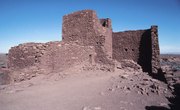
How Pueblos Were Built

Why Was the Fertile Crescent a Major Means of Migration in Ancient ...
- Ancient History Encyclopedia: Sumerian Civilization: Inventing the Future
- Bright Hub Engineering: Ancient Mesopotamia Sailboats: An Introduction
- Khan Academy: The Sumerians and Mesopotamia
Ashley Friedman is a freelance writer with experience writing about education for a variety of organizations and educational institutions as well as online media sites. She has written for Pearson Education, The University of Miami, The New York City Teaching Fellows, New Visions for Public Schools, and a number of independent secondary schools. She lives in Los Angeles.

Sumerian Art – The Pottery, Carvings, and Architecture of Sumer Art
Considered the cradle of Civilization, ancient Mesopotamia was home to Sumer, located in the southern parts and one of its earliest and advanced civilizations during the Neolithic and early Bronze age. This article will explore the Sumerian culture and their artwork, ranging from pottery, statues, and architecture.
Table of Contents
- 1.1.1 The Importance of Uruk
- 2.1 Ram in a Thicket (c. 2 600 BC to 2 400 BC)
- 2.2 Standard of Ur (c. 2 600 BC to 2 400 BC)
- 2.3 The Queen’s Lyre (c. 2 600 BC)
- 2.4 Warka (Uruk) Vase (c. 3 200 BC – 3 000 BC)
- 3 Sumerian Architecture
- 4 From Writing to Wheels: The Sumerians Remembered
- 5.1 When Was the Sumerian Period?
- 5.2 What Does “Sumer” Mean?
- 5.3 What Kind of Art Was Created in Sumer?
- 5.4 What Was the Purpose of Sumerian Art?
Brief Historical Overview: “The Land Between the Rivers”
The Fertile Crescent can be found in the Near Middle East. It is also considered a Cradle of Civilization because of the rate of evolution of farming settlements, domestication, and other technological and cultural advancements like the wheel and writing. The name was introduced as the “Fertile Crescent” by the archaeologist James Henry Breasted in the publications Outlines of History (1914) and Ancient Times, A History of the Early World (1916). He described this region of the Middle East as follows:
“This fertile crescent is approximately a semi-circle, with the open side toward the south, having the west end at the southeast corner of the Mediterranean, the center directly north of Arabia, and the east end at the north end of the Persian Gulf”.

Other sources describe it as a “boomerang” shape, with the various regions surrounding it. These regions include areas of present-day Cyprus, Egypt, Iran, Iraq, Israel, Jordan, Lebanon, Palestine, Syria, and Turkey.
As the name suggests, it was a fertile region with arable land and fresh water sources. Its vast biodiversity made it fit for farming and agriculture thousands of years ago when hunter-gatherers gradually transitioned to a more settled way of life. It is also located between North Africa and Eurasia and has been described as a “bridge” between these two regions.
It is no wonder then that the Fertile Crescent has been regarded as a Cradle of Civilization – it has been the birthplace of development and advancements of not only human civilization but also biodiversity.
If we zoom in to some of the first human civilizations that started here, we will find ancient Mesopotamia , which is now in the region of present-day Iraq, and other regions like Iran, Syria, Turkey, and Kuwait. Mesopotamia lies between the Tigris and Euphrates rivers and the name means the “land between the rivers”. It is one of four other river valley civilizations, the others being the Indus Valley Civilization, the Nile Valley in ancient Egypt , the Yellow River in ancient China.
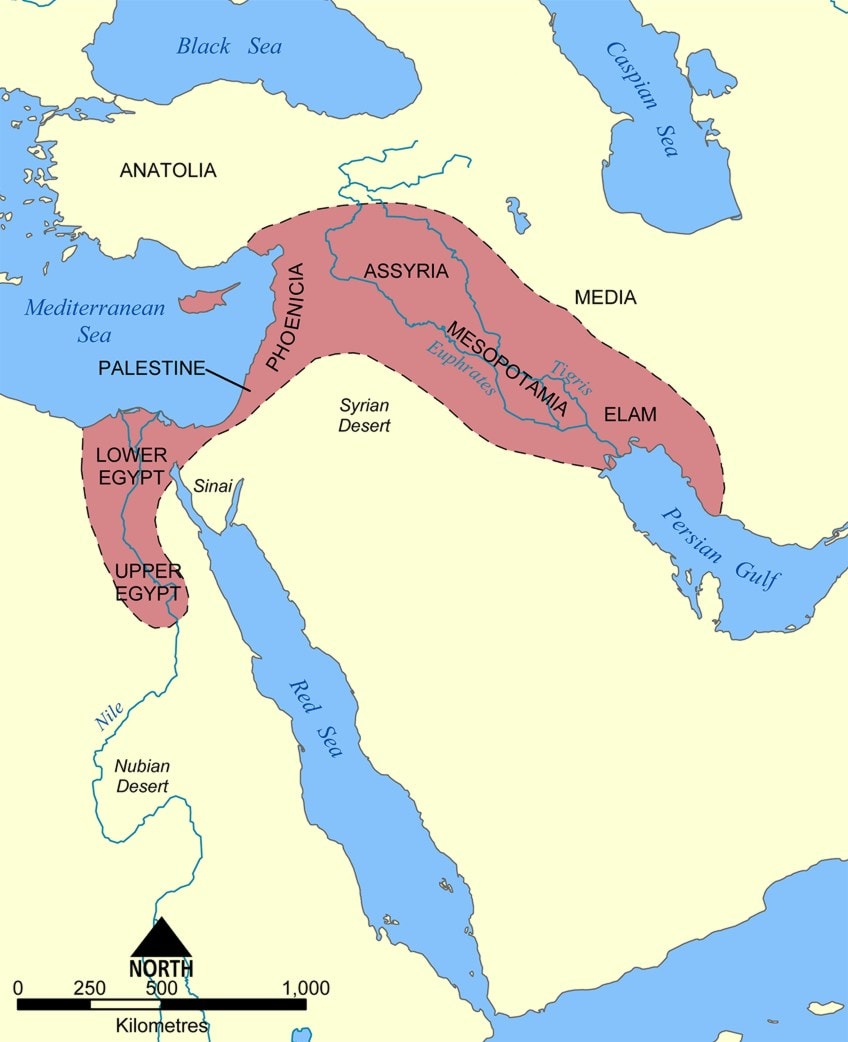
Some historical scholars also suggest that the Agricultural, otherwise Neolithic, Revolution originated in ancient Mesopotamia. The dates suggested it started around 10 000 BC. Some of the earliest farming settlements or villages discovered date to around 11 500 BC to 7 000 BC. The archaeological site Tell Abu Hureyra is one example of this.
The people from Abu Hureyra are believed to have been hunter-gatherers who progressed to farming. Grinding tools were also excavated from this area, which suggests the inhabitants had access to grains, possibly the harvest of wild grains as it has been suggested.
It has also been discovered that early inhabitants domesticated animals like pigs and sheep also around the time of 11 000 to 9 000 BC, and farmed plants such as barley, flax, lentils, and wheat, dating to around 9 500 BC.
The Mesopotamian cultures were considered advanced in their developments – they created aqueducts, irrigation systems, astronomy, philosophy, the earliest forms of writing, and much more. It was one of the most complex regions in the world because of the diversity of cultures that moved through it.
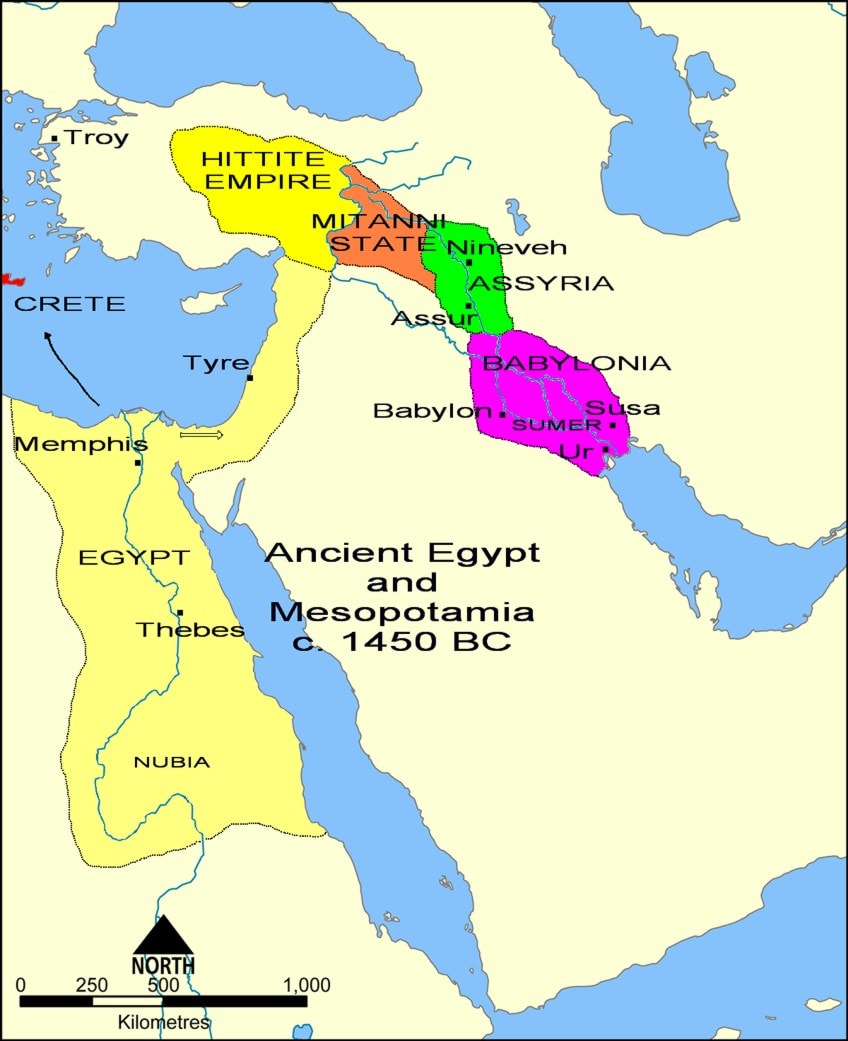
Some of the important civilizations from ancient Mesopotamia include Sumerians, Akkadians, Assyrians, and Babylonians. While there were many city-states throughout Mesopotamia, some of the important cities included the Sumerian Uruk, Ur, and Nippur. There was also Akkad, which was the capital city of the Akkadian Empire, the Assyrian cities Nineveh and Assur, and Babylon, the capital city of the Babylonian Empire.
Earliest Ancient Civilizations: Sumer
Sumer was one of the earliest Mesopotamian civilizations, which originated before the Akkadians, mentioned above. Sumer is in the southern part of Mesopotamia and is believed to have been settled around 4 500 BC to 4 000 BC.
The name “Sumer” was given to the Sumerians by the Akkadians, ironically.
“Black-headed people” or “Black-headed ones” is what the Sumerians used as their name for themselves. The Akkadians also used this terminology for the Sumerians. The word Kengir , meaning “Country of the Noble Lords” was the name the Sumerians used for their land.
There is a lot of scholarly debate about who the first people were to settle in Sumer; some suggest West Asian and others North African. It is generally believed that the first populations or settlements in Sumer were the Ubaidians or “proto-Euphrateans”.

According to various sources, the Ubaidians started agriculture by draining the surrounding marshes, they also developed trading systems and various crafts like weaving, metalwork, leatherwork, pottery, and masonry. The first and oldest settlement was believed to be Eridu, located southwest of the city called Ur.
Eridu was reportedly among five of the cities that were ruled by either a king or a “priestly governor” before floods were destroyed. The settlements were built around respective temples that venerated a patron god or goddess.
The Sumerian god, Enki, was also believed to have originated from Eridu at a place called Abzu, the waters or ocean, otherwise aquifers, under the earth; he was the god of water. Enki’s temple, otherwise referred to as the “House of the Aquifer”, was in the center of Eridu. The other pre-flood Sumerian cities include Bad-tibira, Larak, Sippar, and Shuruppak.
The Importance of Uruk
Uruk was considered one of the first “real” city-states when Sumerian civilization became more urbanized. It started around 4 000 BC and lasted until around 3 200 BC. There were various state formations like societal stratifications, military, and administration systems. It was divided into the Early Uruk Period (c. 4 000 BC to 3 500 BC) and the Late Uruk Period (3 500 BC to 3 100 BC).
It was one of the largest city-states in southern Mesopotamia with around 40,000 inhabitants and an estimation of around 80,000 to 90,000 people in the surrounding areas. It is believed to have reached its peak around 2 800 BC.
The Sumerian King List reportedly indicates that Uruk had five dynasties. It is worth noting that the fifth ruler (of the first dynasty) was the famous Gilgamesh who ruled around 2 900 BC to 2 700 BC. He was also the subject of the epic poem called the Epic of Gilgamesh (c. 2 100 BC to 1 200 BC).

Uruk is an important Sumerian city to note because of its advancements in urbanization as we will see from the wide range of the Sumerians’ architecture. Included were cultural advancements like writing, which is now known as the cuneiform script. It was initially used to record business transactions. These transactions were for purposes of keeping records of food and cattle. It was used by the ruling priests of the area.
The cuneiform script was made by pressing down a cut edge from a reed onto a clay tablet that was still soft. This created a shape that appeared like a wedge. The name also originates from the Latin meaning “wedge-shaped”.
This written language became a very flexible one because it could convey not only words but also numbers and concepts.
Sumerian Art
The Sumerian civilization was not only advanced in agriculture, economics, and many other facets of life, but they were also artists and builders. Their artworks served different purposes and functions and the addition of decorative elements gave any object a new character.
We will see this in the numerous Sumerian statues throughout the different dynasties. For example, the Standing Male Worshipper (c. 2 900 BC to 2 600 BC), now housed in the Metropolitan Museum of Art in New York, depicting a man standing with both his hands cupped in front of his breastbone with a lustrous long beard and open eyes gazing outward; his facial features have been sculpted in an animated manner.

Not only were the Sumerians skilled at pottery and sculpture, but they produced beautiful pieces with these decorative elements made from semi-precious stones like alabaster, lapis lazuli, and serpentine to name a few. Some of these stones were also imported. They used metals like silver, gold, bronze, and copper as inlays and designs on various objects.
The Sumerians also used stone and clay. Clay was a popular medium to work with, possibly due to the clay present from the soil, and we will see a lot of Sumer art made from it. Decorative elements would adorn various items like jewelry, carved heads, musical instruments, ornamentation, weapons, cylinder seals, and many others.
The majority of Sumer art originates from gravesites; indeed, many objects, often important objects, were buried with the dead.
This also tells us that art served strong religious purposes during this period. One of the most important archaeological discoveries in history has been that of Sir Leonard Woolley, his wife Katharine Woolley, and their collaboration with the British Museum and the Museum of University of Pennsylvania.
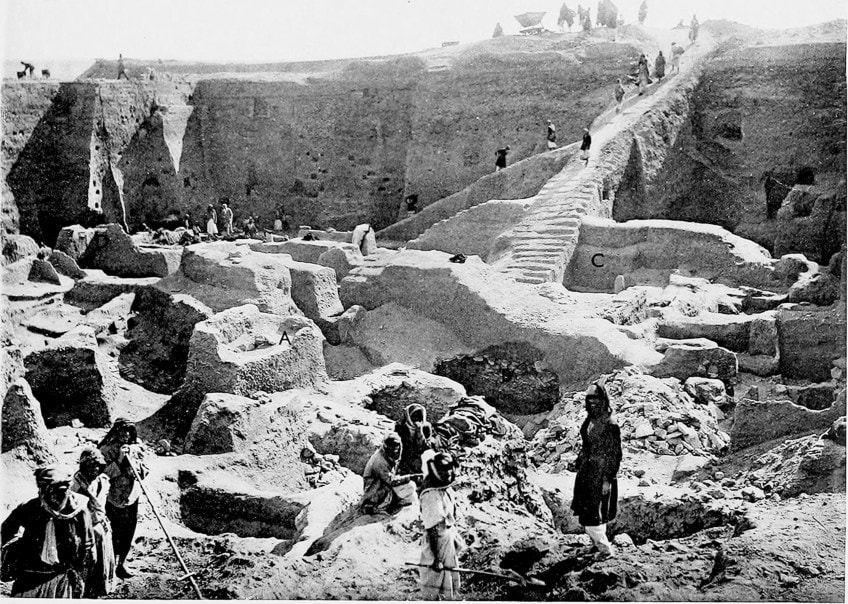
From 1922 to 1934, Woolley, who was a British archaeologist, led an excavation at one of the Sumerian cities called Ur. The layout of the city consisted of central mud-brick temples with a surrounding cemetery. This is also where they discovered the Royal Cemetery, which was reportedly in an area used as a large rubbish heap where people could not build.
Instead, it was utilized as a burial site with various tombs that are believed to have belonged to Sumerian royalties.
The cemetery was dated from around 2 600 BC to 2 000 BC and the discovery of 16 graves dates these to around the middle of 3 000 BC. The tombs were also different in arrangement and size. The excavation team reportedly found over 2000 burials.

The tombs housed a plethora of objects like pottery including bowls, jars, and vases, jewelry, cylinder seals with inscriptions of the names of those who were dead, musical instruments of which lyres were quite prominent, sculptures, Sumer paintings, and many others.
One of the famous burial sites belonged to a woman, believed to be a “queen”, called Puabi.
She lived in the First Dynasty of Ur, around 2 600 BC. She was referred to as nin from the discovered cylinder seals. Nin is a Sumerian word that was used to refer to someone who was designated as a queen or priestess. It has also been translated to mean “lady”.
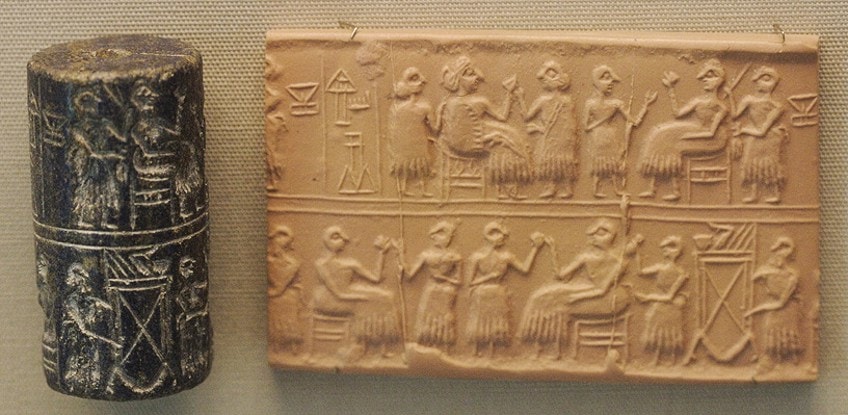
Her burial grave included numerous items that were tied to wealth, these were also high in quality items like jewelry, headdresses, including her own headdress with gold floral motifs and beads made from lapis lazuli and carnelian.
Sources also state these gravesites were looted over the years except for Puabi’s grave, which undoubtedly elicited questions about her status and importance in the Sumerian society.
It is important to remember there are hundreds of discovered Sumerian artifacts, all from different regions and all with different purposes and stories. Below we will discuss only a few of the famous pieces of Sumerian art, including, but not limited to some of the items discovered from the Royal Graves, including that of Puabi’s grave. It is encouraged to undertake more extensive research to discover all the other unique and beautiful Sumerian art pieces that adorn our museums in the present day.
Ram in a Thicket (c. 2 600 BC to 2 400 BC)
The Ram in a Thicket (c. 2 600 BC to 2 400 BC) is a figurine of a ram, really a goat, standing on its hind legs in front of what looks like a tree, possibly reaching for some food. This figurine came in a pair; the two were excavated from what was called the “Great Death Pit” in the Royal Cemetery at Ur, lying not too far apart from each other.
The British excavator, Leonard Woolley chose the name, Ram in a Thicket , because it resembled a reference from the book of Genesis, 22:13, in the Bible when Abraham was about to sacrifice Isaac, his son:
“Then Abraham looked up and saw a ram caught by its horns in a thicket. So he took the ram and sacrificed it as a burnt offering in place of his son”.

The figure measures 45.7 x 30.48 centimeters and is composed of silver, gold, lapis lazuli, shell, copper alloy, red limestone, and bitumen. An interesting fact about bitumen (or asphalt) is that the Sumerians used it as an adhesive. The Sumerian word for bitumen is believed to be esir .
If we look more closely at the Ram in a Thicket, we will notice it has a wooden core. The head and legs are covered in gold leaf that is attached to the wood; the adhesive qualities of bitumen keep it pasted on. The ears are made from copper. The horns are made from lapis lazuli.
From the dorsal view of the ram, there is what appears to be a fleece covering its upper shoulder area, which is also made from lapis lazuli; the fleece that covers the rest of its body is made from shell, also stuck on using bitumen. The ventral view shows the ram’s stomach area is made from a silver plate, but this is reportedly oxidized and unrepairable. The ram’s genitals are made from gold.

The tree itself is golden in color, made from gold leaf with gold flowers at the end of each branch. Both the ram and tree are on a small rectangular platform made from shell, lapis lazuli, and red limestone. It appears like a mosaic pattern covering the base. There is also a small tube protruding from each ram’s upper shoulder area, believed to have possibly been for supporting an object like a bowl.
Currently, the rams are in two different museums, one is in the British Museum’s Mesopotamia Gallery in London. The other ram is in the University of Pennsylvania Museum of Archaeology and Anthropology.
Standard of Ur (c. 2 600 BC to 2 400 BC)
The Standard of Ur (c. 2 600 BC to 2 400 BC) was excavated from the Royal Cemetery at Ur, also during the excavations led by Leonard Woolley. It was found near the shoulder of a man in the corner of a tomb believed to have been dedicated to Ur-Pabilsag, a king during the First Dynasty of Ur during the 26 th century BC.
Woolley suggested the item was used as a standard, which is related to someone carrying an image that relates to a person of high status like a king in this regard.
However, there has been debate as to the real function of this item, some also suggested it was used as a storage box or a sound box. The item was considerably damaged over the centuries from the weight of the soil and the decay of the wood. There have been restoration attempts made to make it appear how it could have looked when it was used.

As we see it now, it is a hollow wooden box measuring 21.59 centimeters in width and 49.53 centimeters in length. There are inlays along each length and end of the box. These are made from red limestone, lapis lazuli, and shell, in a mosaic format. The box’s length is divided into three panels.
What is so unique about this box is that the mosaic inlays are depicted in detail telling a visual story. The narrative and subject matter have been titled “War” and “Peace” because there are figures that relate to the military and other figures that appear to be involved in a banquet.
If we look closer, the “War” panel depicts various figures from the Sumerian army. In the top panel, from the left, we see a man standing by a wagon pulled by four donkeys. There are members of the infantry with cloaks and spears and a central, taller, figure, possibly the king, holding a spear awaiting a procession of oncoming prisoners from the right. Each prisoner seems to be naked and possibly escorted by members of the infantry.
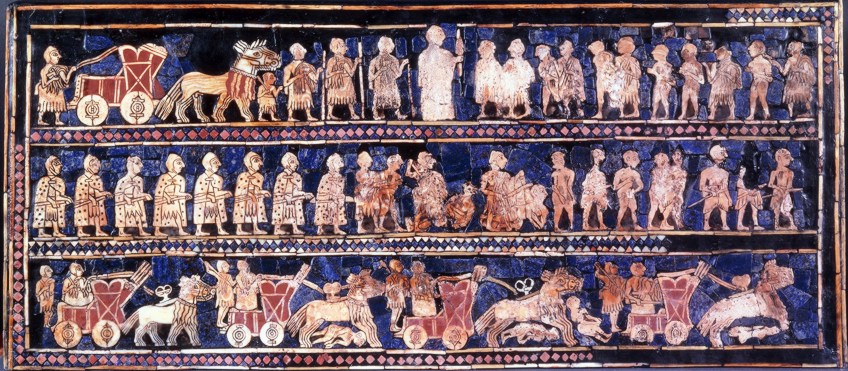
The middle panel depicts what appears to be more members of the army and perpetrators being struck and killed. From the left, there are eight men wearing the same military garments (cloaks and helmets) with weapons. It appears as if they are approaching an ongoing battle that we see depicted on the right side of the panel. The lower panel of the box depicts four wagons led by four donkeys for each. In each wagon, there is a driver and a soldier ready to fight. We will also notice under three of the wagons are dead bodies of the enemies killed from the wagon’s weight and those on it.
The wheels depicted on the wagons are solid structures, a telling portrayal of what it could have looked like in real life.
There is also a dynamism portrayed in the donkey’s stances; from the left, the first wagon with donkeys is seemingly walking, the wagon and donkeys in front of them seem to be going at a bit of a faster pace, otherwise referred to as a canter. The third set of wagons and donkeys appear to be galloping and the last set of donkeys are rearing.
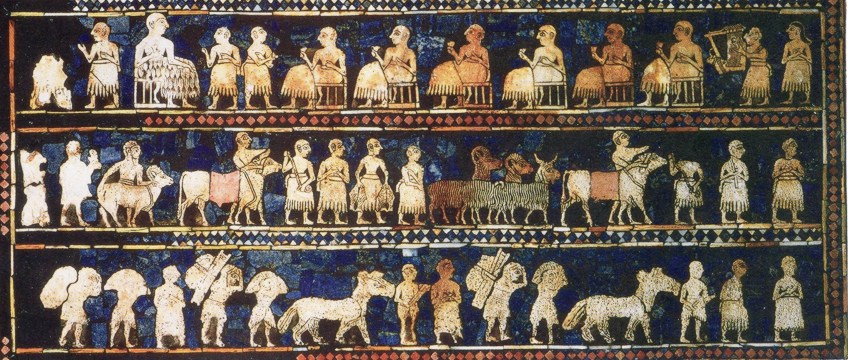
If we look at the “Peace” panels, starting from the top panel, we will see the king on a stool to the left. There are six figures, also seated, holding cups in their right hands, all facing the king, who also holds a cup in his right hand. There are various attendants and a musician holding a lyre, standing as the second figure from the right side. In the middle portion of the “Peace” panel, we will notice various figures ushering in animals that appear to be rams and cows. Some figures also appear to hold fish.
The lower portion of the panel depicts figures with donkeys and packs on the backs, possibly of foodstuffs. These processions of figures from the middle and lower portion of the panel could be on their way to the banquet with offerings towards the feast.
The Queen’s Lyre (c. 2 600 BC)
The Queen’s Lyre (c. 2 600 BC) was found amongst numerous other lyres from the Royal Cemetery at Ur. With a height of 112.50 centimeters and a length of 73 centimeters, this Lyre was found at Queen Puabi’s gravesite. The wood that composed it was damaged from all the years in the gravesite, but it has been restored in various parts. Leonard Woolley reportedly found two lyres in the queen’s grave.
When we look at it more closely, we see the music box is in the shape of a bull. The head and face are gold with lapis lazuli composing the head’s hair, the “beard” of hair under the bull’s face, and its eyes, which are also made from shell. The two white horns are apparently not part of the original, ancient, figure, but modern additions that give us an indication of what it looked like.
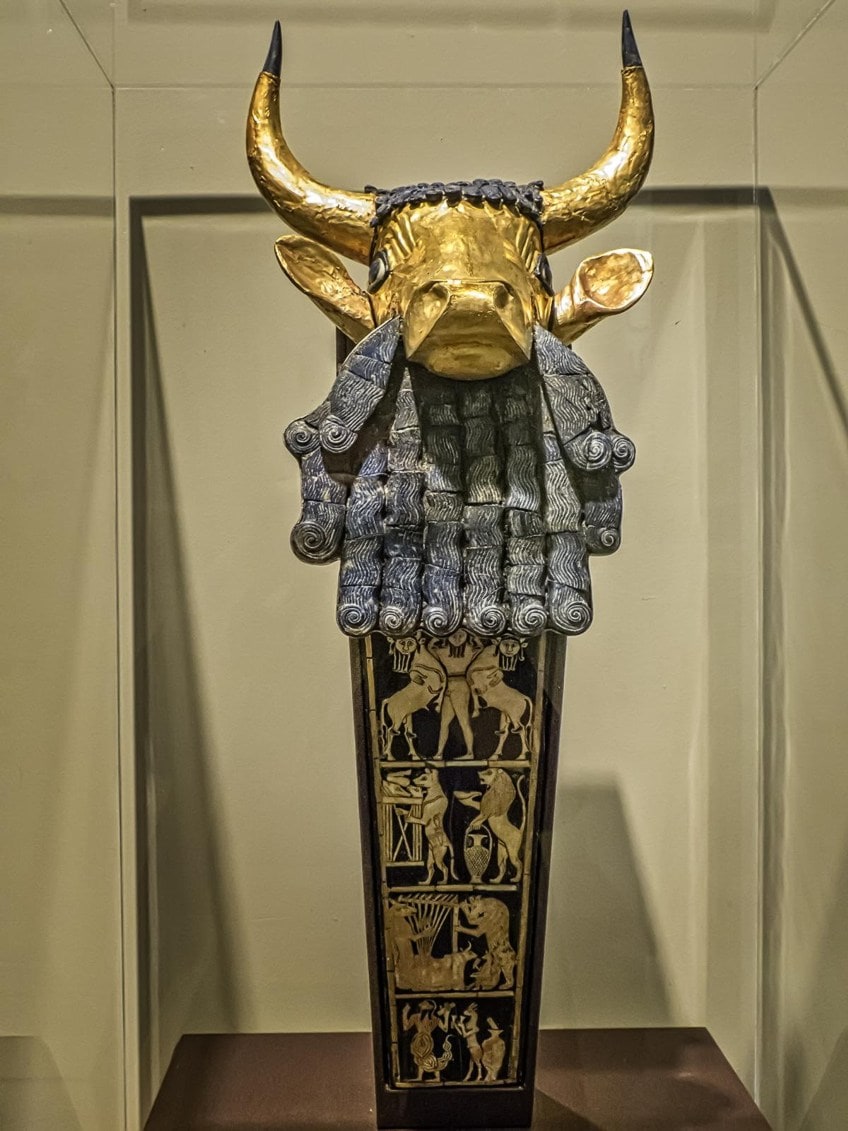
As we move further down, what would theoretically be towards the ventral view of the bull’s body, but is really the curving of the music box, we see the similar mosaic panels made from the same material as the above Standard of Ur , shell, red limestone, and lapis lazuli.
This front panel is divided into four squares, each depicting images.
The top image is an eagle with a lion’s head and spread wings with two flanking gazelles. The next image is described by various sources as “bulls with plants on hills”. However, when we look closely these appear like two rams standing on their hind legs reaching up a tree on some sort of basal mound. These are reminiscent of the Ram in a Thicket figurines.
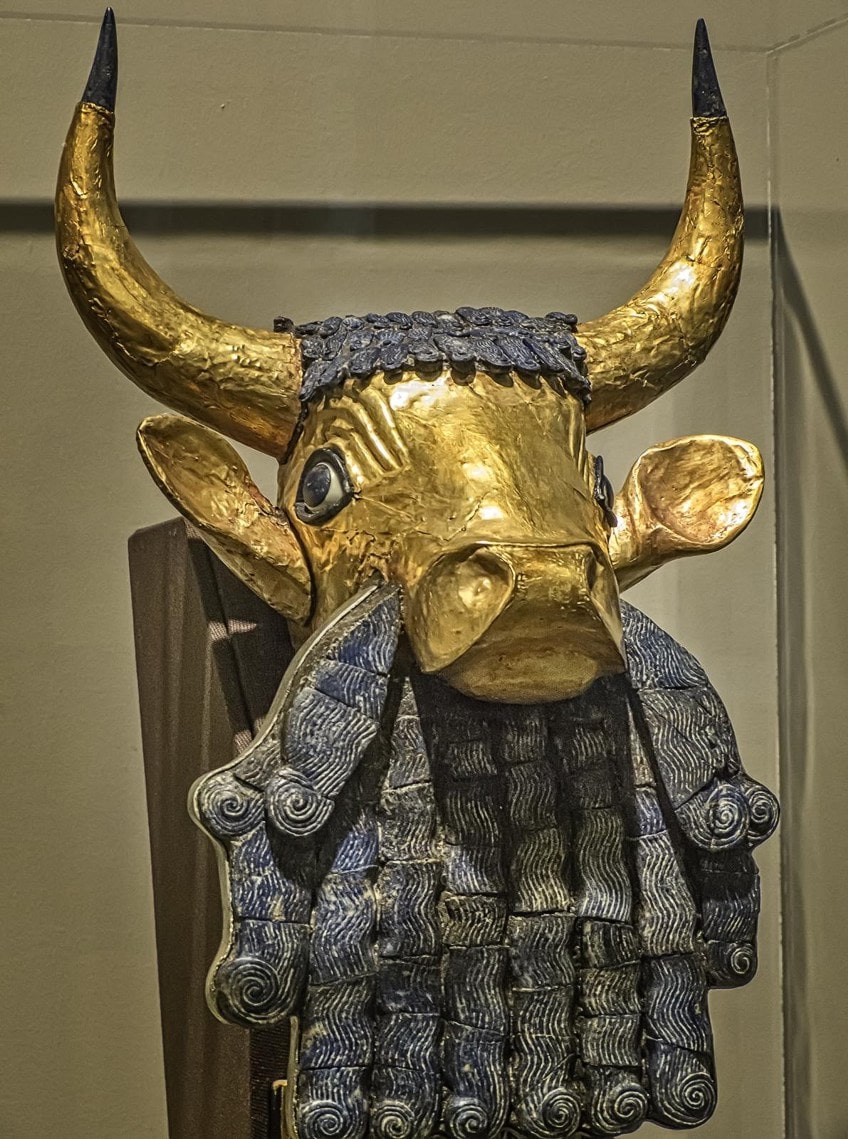
The third square, so to say, depicts a figure with the body of a ram or bull and the torso of a man, holding up two Leopards (or Cheetahs?) by their hind legs. The last square depicts a lion busy sinking its teeth into a bull. There is also a tree shape in the background, similar in appearance to the two trees from the second square.
Warka (Uruk) Vase (c. 3 200 BC – 3 000 BC)
Warka is the modern name for the ancient Sumerian city that was called Uruk. The alabaster Warka Vase (c. 3 200 BC to 3 000 BC) is another example of the beauty of Sumerian carvings. The measurements have been debated for this vessel, as a field book entry from 1934 (when it was found) stated it was around 96 centimeters high, whereas other sources state it is 105 and 106 centimeters high.
Regardless of its measurements, it is safe to say it is around one meter tall. Its diameter is measured as being 36 centimeters.
The Warka Vase was found by a group of German excavators around the years 1933 to 1934. It was in the temple dedicated to the Sumerian goddess called Inanna. She presided over beauty, sex, love, justice, and war. The Sumerian carvings are done as relief carvings and span around the vessel divided into four panels, otherwise known as registers.
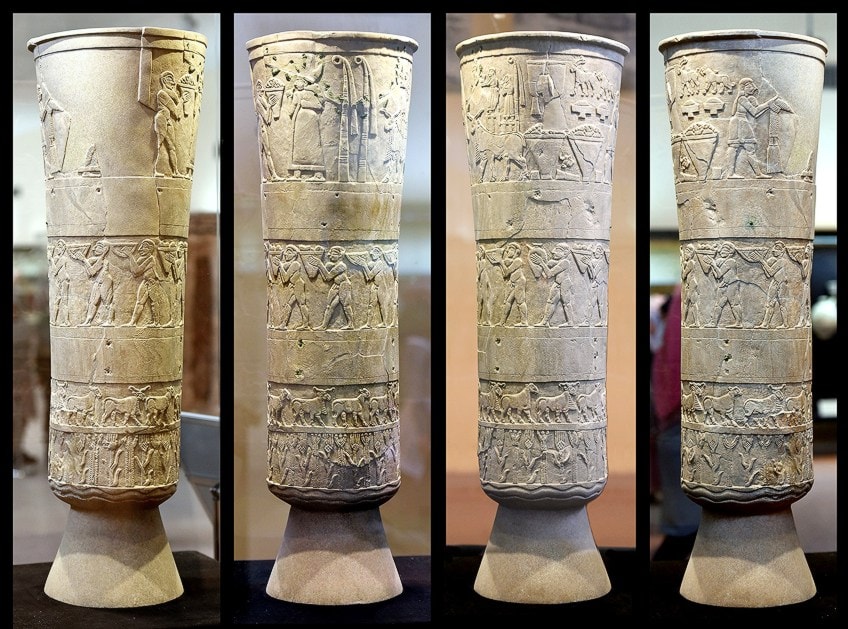
Each register depicts different figures and objects from nature; the bottom panel is filled with water at the bottom and growing crops of what appears to be barley and wheat amidst reeds; the second panel depicts rams and ewes. In the third panel, we see nine nude figures of men carrying containers or baskets with food in it. The top panel depicts more characters, including the goddess Inanna and the king.
There are differing ideas as to what narrative the subject matter portrays; some suggest it is a marriage between the king and queen and others that it is a celebration of the queen. This vessel is housed in the National Museum of Iraq.
Sumerian Architecture
The Sumerians’ architecture is another important part of not only Sumer culture, but Sumer art. Most buildings were made of clay bricks, a widely spread material. Sumerians were also known as one of the first cultures to undertake urban or city planning. Buildings ranged from houses to palaces and there were different functions, for example, commercial, civic, and residential.
As described from a few examples above, we will typically find a temple as a central building.

The Ziggurat was an important structure, in the shape of a pyramidal tower, or “raised platform”. It was built to venerate the dedicated god or goddess, and a reminder of the political leaders who acted on behalf of that deity, this was a large part of the Sumerian theocratic system.
An example of the above was the White Temple (c. 3517 BC to 3358 BC) built on the Anu Ziggurat in Uruk. Anu was the god of the sky. However, almost over 30 such temples are recorded to exist in various locations around Mesopotamia.

From Writing to Wheels: The Sumerians Remembered
The Sumerian civilization was succeeded by the Akkadians, led by the ruler Sargon of Akkad, from 2334 BC to 2154 BC. After the Akkadian Empire fell there was a period referred to as a “Dark Age” after which there was a resurgence in Sumerian culture with the beginning of the Third Dynasty of Ur (2112 BC to 2004 BC). This was also called the Neo-Sumerian period. It has been compared to a sort of “Golden Age” of the Sumerian Civilization and revival of arts, especially religious arts.
The Sumerians were undoubtedly advanced in many ways, setting the stage for many civilizations to come in so many disciplines in life like art, science, religion, politics, agriculture, and more. They have been lauded as some of the greatest ancient inventors, think of the wheel and writing. And now in our modern-day, we still remember them as a civilization rich in culture, adorned with gems of wisdom just like the art they created.
Take a look at our Sumerian art period webstory here!
Frequently Asked Questions
When was the sumerian period.
Sumer was one of the earliest Mesopotamian civilizations originating before the Akkadian Civilization. Sumer is in the southern part of Mesopotamia and is believed to have been settled around 4 500 BC to 4 000 BC.
What Does “Sumer” Mean?
The name Sumer was given to the Sumerians by the Akkadians. “Black-headed people” or “Black-headed ones” is what the Sumerians used as their name for themselves. The word Kengir , meaning “Country of the Noble Lords” was the name the Sumerians used for their land.
What Kind of Art Was Created in Sumer?
The Sumerians created art from different materials like semi-precious stones, shells, wood, red limestone, metals like gold, silver, and copper, to name a few. These were all used in Sumer paintings and mosaics. Sumerian statues, sculptures, figurines, pottery, and various other objects were also discovered in large quantities by various archaeological excavations. The Sumerians’ architecture and tablets to write on in the cuneiform script were mostly built using clay as this was a widespread and naturally occurring medium.
What Was the Purpose of Sumerian Art?
Sumerian art was beautifully decorated with ornamentations and served religious and sacred purposes. Many of the Sumer art objects were discovered from gravesites and were buried with their respective owners. Temples were important structures and were given great care in construction for the purposes of venerating respective deities.

Isabella studied at the University of Cape Town in South Africa and graduated with a Bachelor of Arts majoring in English Literature & Language and Psychology. Throughout her undergraduate years, she took Art History as an additional subject and absolutely loved it. Building on from her art history knowledge that began in high school, art has always been a particular area of fascination for her. From learning about artworks previously unknown to her, or sharpening her existing understanding of specific works, the ability to continue learning within this interesting sphere excites her greatly.
Her focal points of interest in art history encompass profiling specific artists and art movements, as it is these areas where she is able to really dig deep into the rich narrative of the art world. Additionally, she particularly enjoys exploring the different artistic styles of the 20 th century, as well as the important impact that female artists have had on the development of art history.
Learn more about Isabella Meyer and the Art in Context Team .
Cite this Article
Isabella, Meyer, “Sumerian Art – The Pottery, Carvings, and Architecture of Sumer Art.” Art in Context. December 8, 2021. URL: https://artincontext.org/sumerian-art/
Meyer, I. (2021, 8 December). Sumerian Art – The Pottery, Carvings, and Architecture of Sumer Art. Art in Context. https://artincontext.org/sumerian-art/
Meyer, Isabella. “Sumerian Art – The Pottery, Carvings, and Architecture of Sumer Art.” Art in Context , December 8, 2021. https://artincontext.org/sumerian-art/ .
Similar Posts
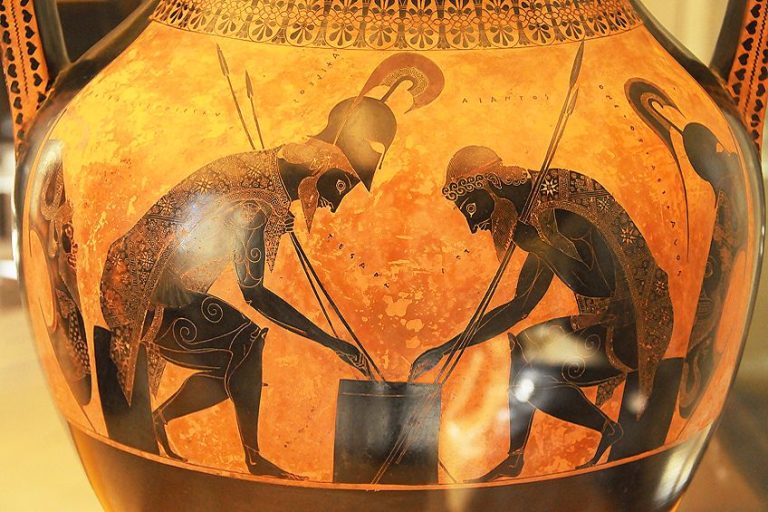
Greek Pottery – History of Ceramics in Ancient Greece
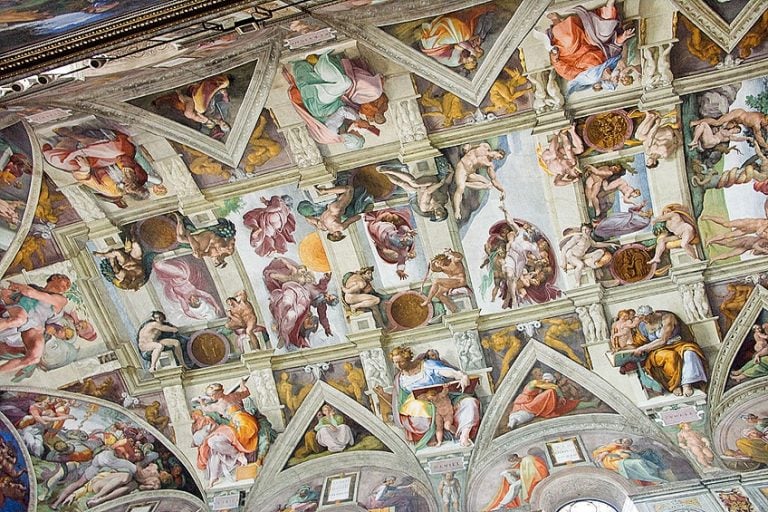
Fresco Painting – The Age-Old Art of Applying Paint to Plaster
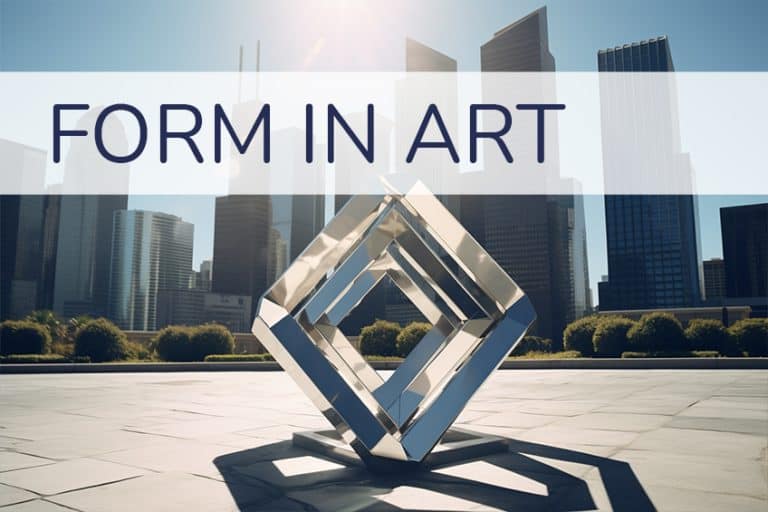
Form in Art – Exploring the Element of Form through Examples
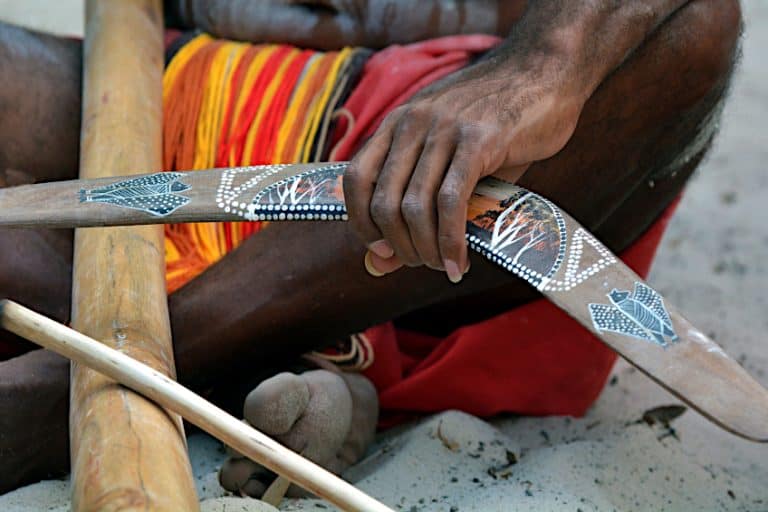
What Are Artifacts? – The Historical and Cultural Value of Objects
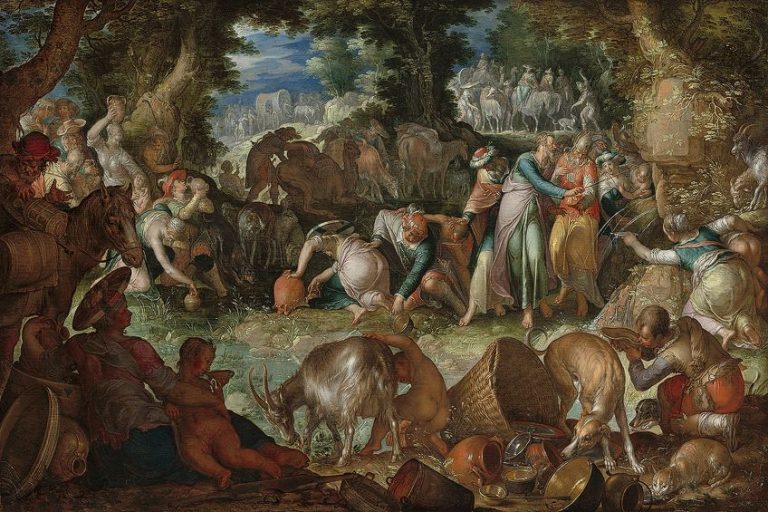
Early Christian Art – Christian Artwork and Biblical Paintings
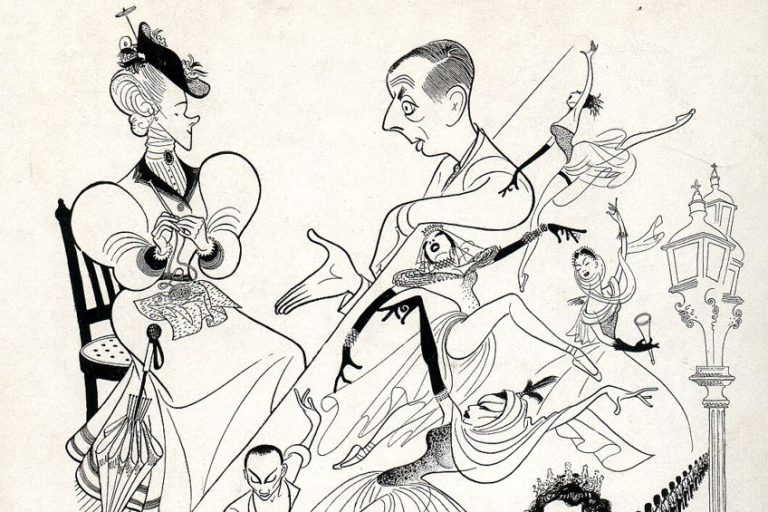
Caricature Art – The History of Caricature Paintings
Leave a reply cancel reply.
Your email address will not be published. Required fields are marked *
Save my name, email, and website in this browser for the next time I comment.
The Most Famous Artists and Artworks
Discover the most famous artists, paintings, sculptors…in all of history!

MOST FAMOUS ARTISTS AND ARTWORKS
Discover the most famous artists, paintings, sculptors!

Mesopotamian Reed Boats Changed the Stone Age
Emily Hopper / Pexels
- Ancient Civilizations
- Excavations
- History of Animal and Plant Domestication
- M.A., Anthropology, University of Iowa
- B.Ed., Illinois State University
Mesopotamian reed boats constitute the earliest known evidence for deliberately constructed sailing ships, dated to the early Neolithic Ubaid culture of Mesopotamia , about 5500 B.C.E. The small, masted Mesopotamian boats are believed to have facilitated minor but significant long-distance trade between the emerging villages of the Fertile Crescent and the Arabian Neolithic communities of the Persian Gulf. Boatmen followed the Tigris and Euphrates rivers down into the Persian Gulf and along the coasts of Saudi Arabia, Bahrain, and Qatar. The first evidence of Ubaidian boat traffic into the Persian Gulf was recognized in the mid-20th century when examples of Ubaidian pottery were found in scores of coastal Persian gulf sites.
However, it is best to keep in mind that the history of sea-faring is quite ancient. Archaeologists are convinced that both the human settlement of Australia (about 50,000 years ago) and the Americas (about 20,000 years ago) must have been assisted by some sort of watercraft to assist moving people along the coastlines and across large bodies of water. It is quite likely that we will find older ships than those of Mesopotamia. Scholars are not even necessarily certain that Ubaid boat-making originated there. But at present, the Mesopotamian boats are the oldest known.
Ubaid Boats, the Mesopotamian Ships
Archaeologists have assembled quite a bit of evidence about the ships themselves. Ceramic boat models have been found at numerous Ubaid sites, including Ubaid, Eridu , Oueili, Uruk , Uqair, and Mashnaqa, as well as at the Arabian Neolithic sites of H3 located on the northern coast of Kuwait and Dalma in Abu Dhabi. Based on the boat models, the boats were similar in form to bellums (spelled bellams in some texts) used today on the Persian Gulf: small, canoe-shaped boats with upturned and sometimes elaborately decorated bow tips.
Unlike wooden planked bellams, Ubaid ships were made from bundles of reeds roped together and covered with a thick layer of bituminous material for water-proofing. An impression of string on one of several bitumen slabs found at H3 suggests that the boats may have had a lattice of ropes stretched across the hull, similar to that used in later Bronze Age ships from the region.
In addition, bellams are usually pushed along by poles, and at least some of the Ubaid boats were apparently had masts to enable them to hoist sails to catch the wind. An image of a boat on a reworked Ubaid 3 sherd (a ceramic fragment) at the H3 site in coastal Kuwait had two masts.
Trade Items
Very few explicitly Ubaidian artifacts have been found in the Arabian Neolithic sites apart from bitumen chunks, black-on-buff pottery, and boat effigies, and those are fairly rare. Trade items might have been perishables, perhaps textiles or grain, but the trade efforts were likely minimal, consisting of small boats dropping in at Arabian coastal towns. It was a fairly long distance between the Ubaid communities and the Arabian coastline, approximately 450 kilometers (280 miles) between Ur and Kuwait. Trade does not seem to have played a significant role in either culture.
It is possible that the trade included bitumen, a type of asphalt. Bitumen tested from Early Ubaid Chogha Mish, Tell el'Oueili, and Tell Sabi Abyad all come from a wide variety of different sources. Some come from northwestern Iran, northern Iraq, and southern Turkey. Bitumen from H3 was identified as having an origin at Burgan Hill in Kuwait. Some of the other Arabian Neolithic sites in the Persian Gulf imported their bitumen from the Mosul area of Iraq, and it is possible that boats were involved in that. Lapis lazuli, turquoise, and copper were exotics in the Mesopotamian Ubaid sites that potentially could have been imported, in small amounts, using boat traffic.
Boat Repair and Gilgamesh
Bitumen caulking of the reed boats was made by applying a heated mixture of bitumen, vegetal matter, and mineral additives and allowing it to dry and cool to a tough, elastic covering. Unfortunately, that had to be replaced frequently. Hundreds of slabs of reed-impressed bitumen have been recovered from several sites in the Persian Gulf. It may be that the H3 site in Kuwait represents a place where boats were repaired, although no additional evidence (such as woodworking tools) was recovered to support that.
Interestingly, reed boats are an important part of Near Eastern mythologies. In the Mesopotamian Gilgamesh myth, Sargon the Great of Akkad is described as having floated as an infant in a bitumen-coated reed basket down the Euphrates River. This must be the original form of the legend found in the Old Testament book of Exodus where the infant Moses floated down the Nile in a reed basket daubed with bitumen and pitch.
Carter, Robert A. (Editor). "Beyond the Ubaid: Transformation and Integration in the Late Prehistoric Societies of the Middle East." Studies in Ancient Oriental Civilizations, Oriental Institute of the University of Chicago, September 15, 2010.
Connan, Jacques. "An overview of bitumen trade in the Near East from the Neolithic (c.8000 BC) to the early Islamic period." Thomas Van de Velde, Arabian Archaeology and Epigraphy, Wiley Online Library, April 7, 2010.
Oron, Asaf. "Early Maritime Activity on the Dead Sea: Bitumen Harvesting and the Possible Use of Reed Watercraft." Ehud Galili, Gideon Hadas, et al., Journal of Maritime Archaeology, Volume 10, Issue 1, The SAO/NASA Astrophysics Data System, April 2015.
Stein, Gil J. "Oriental Institute 2009-2010 Annual Report." Oriental Institute, The University of Chicago, 2009-2010, Chicago, IL.
Wilkinson, T. J. (Editor). "Models of Mesopotamian Landscapes: How small-scale processes contributed to the growth of early civilizations." BAR International Series, McGuire Gibson (Editor), Magnus Widell (Editor), British Archaeological Reports, October 20, 2013.
- The Archaeology and History of Bitumen
- Fast Facts About Mesopotamia
- Timeline and Advances of the Mesopotamian Society
- Ubaidian Culture
- Eridu (Iraq): The Earliest City in Mesopotamia and the World
- Uruk Period Mesopotamia: The Rise of Sumer
- Kuwait | Facts and History
- The Tigris River of Ancient Mesopotamia
- Tell Brak - Mesopotamian Capital in Syria
- An Introduction to Sumerian Art and Culture
- The Most Important Rivers of Ancient History
- An Introduction to Sumer in Ancient History
- What Was the Fertile Crescent?
- Uruk - Mesopotamian Capital City in Iraq
- The Tell Asmar Sculpture Hoard of Prayerful People
- Ancient City of Ur

Old Sumerian Art
By: L. Legrain
Originally Published in 1928
IT is a pure joy for a weary archaeologist to plunge into a study of Oriental art—the oldest known Mesopotamian art—thanks to the rich collection of objects, figures, statues, reliefs, and engravings discovered in the predynastic cemetery at Ur. A new stage of civilization, perfectly unknown a year ago, has now been reached. And to our great surprise, out of the mystery of the past beauty shines with a wonderful glamour. Gold and silver, blue lapis and red carnelian, mother of pearl and shell inlay, lavishly used by the Sumerian artists, show their good taste in the blending of colours, their mastery in the lines of the figures, the boldness and force of their drawings, which have a primitive charm and a subtle refinement such as we find at first hard to reconcile with so early a date. Many of the objects recovered, like the harp, the gaming boards with their sets of ‘men’ and dice, the golden comb so like a Spanish comb, the rings and garter of the queen, the fluted gold tumbler and the chalice, the chariots and their teams, all seem wonderfully familiar and close to us, while the wholesale murder and burial of servants and retainers round the grave of their lord and lady hint at grim customs of hoary ages.
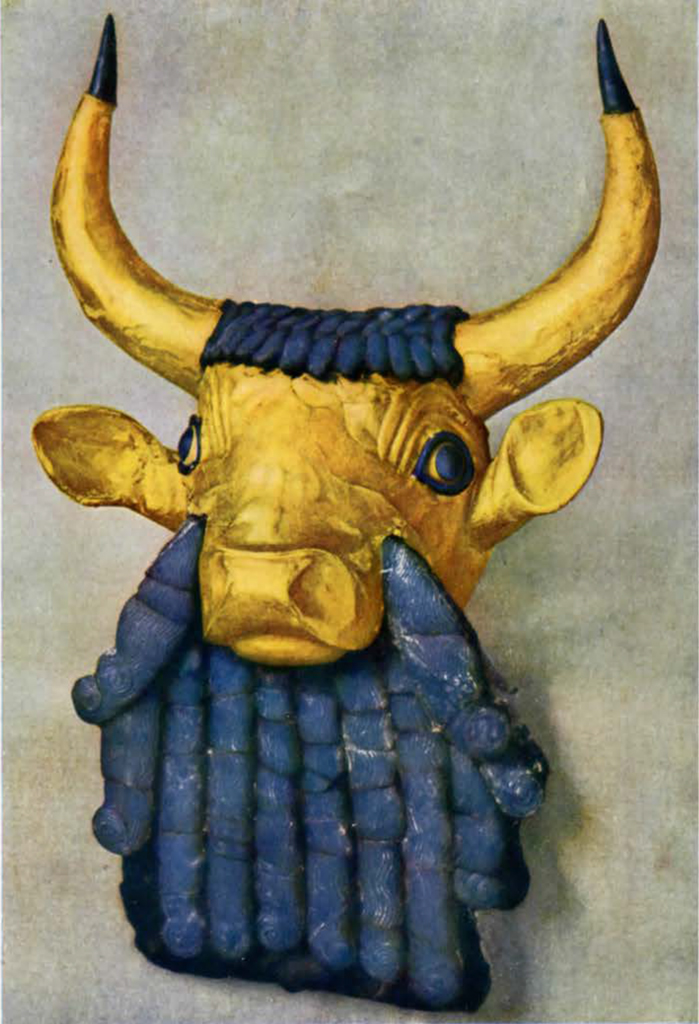
Such beautiful objects were not the work of beginners. Civilization even then was an ancient achievement in Mesopotamia, whence it spread westward. Where shall we look for or place its origin? We do not know. But obviously the old Sumerian art at Ur is already a classical art, with fixed types and school conventions. Modelling, casting, carving, and engraving have no secrets for the expert craftsmen. Their best pieces of work show an ideal of force and dignity not devoid of a certain heaviness, a minute rendering of details, a love of nature and animal life. It is a subtle and curious art which likes inlay and polychromy, delights in the mingling of colours and materials, the blending of low and high relief with boldly salient parts in the round. Its style is surprisingly free and is not abashed by the difficult tracing of figures en face , or the shortening of proportions in perspective. It has even an apparent sense of humour, probably with a deeper meaning, in scenes where animals are given the attitudes and play the parts of men : a dog carries a small altar loaded with offerings, a lion follows him bringing a lamp and the wine of the sacrifice. It is remarkable that the animals are by degrees transformed and given the head, face, locks, beard, arms, feet, and torso of man. We have composite monsters, a bison with a human face, a scorpion-man, a donkey seated and playing the harp with his fingers, a rampant gazelle holding two tumblers, a scaled monkey (?) playing with a rattle and drumming on a board.
This is pure mythology. We are introduced into a world in which animals can play and talk like men : a land of fable such as has always enchanted and will still long delight the children of men. And by the by, that marvellous curled beard hanging below the chin of the man-faced bison is not at all an emblem of divinity, but a sign of human virility. The horned mitre with one, two or four pairs of horns is the only certain emblem of divinity, both for gods and goddesses. So the bull might be a god, even without a beard. The crescent horns are the emblem of the Moon God, called the young bull of heaven. That mighty blue beard simply brings him one step closer to humanity, and may or may not decorate the golden head which animates and gives a voice to the harp “roaring like a bull.”
And here we find a very important link between the old Sumerian art of Ur and the still earlier Elamite civilization—about 4000 B.C.—known through the French excavations at Susa. It is remarkable that the old Elamite artist in all his painting and carving and engraving “never represents a god under human form. But he multiplies animal figures, especially figures of wild species, and gives to them strange attitudes and human gestures. His imagination creates composite monsters, dragons and griffins. And when he reaches a higher stage, it is in scenes where the figures of Gilgamesh and Enkidu are conspicuous and betray a close relation with Babylonia.” 1

“The Gilgamesh and Enkidu contests with wild animals are simply the heroic development of natural hunting scenes by which a contact is established with the archaic or Elamite period. The worshipping of gods in human form with crowns, sceptres, and thrones like kings is a new feature of the Sumero-Akkadian civilisation apparently unknown to the pre-Elamites—and to the predynastic Sumerians of Ur. It supposes regular institutions, city states, courts, and temples modelled on the courts. It expresses a higher ideal of worship no longer limited to stones, animal figures, weapons, and emblems, but to gods akin to humanity.
“Between these two extremes: heroic hunting and regular court worship of the gods, there is a large intermediary layer of mythological figures which seems to connect them and where we see the human god emerging from the beast, or in close contact with the primitive forces of nature. . . . When the gods attained full human stature and royal dignity, the world of heroes and demigods always had a number of bullmen, lionmen, birdmen, fishmen and scorpion-men; while the pure animals: bull, lion, dragon, bird, fish, serpent, scorpion, become simple followers, emblems and servants of the gods.” 2
The eagle, a royal bird, has never attained, as an emblem of divinity, to the popularity of the bull. The eagle triumphs over wild animals, bull, bearded bison, and others. Eagle feathers decorate the heads of Sumerian chiefs, or are an ornament between the horns of the oldest mitre. But they soon disappear and are replaced by two or more pairs of horns, the round crescent horns of the bison, the accepted emblem of divinity. Anthropology and archaeology are both interested in that primitive heraldry. The war eagle of the gods of the atmosphere is the lord of all the creatures of the pasture land. Is not the Moon God like a great bull moving across the pastures of heaven? All Sumer rejoices when his golden horn shines over the horizon, bringing in regular succession months and seasons and years. He is only the son of the god of the atmosphere but he is the guide and teacher of the Sumerian tribes and of their pastors, and his golden crown has impressed them as the highest emblem by which they can distinguish heavenly powers.
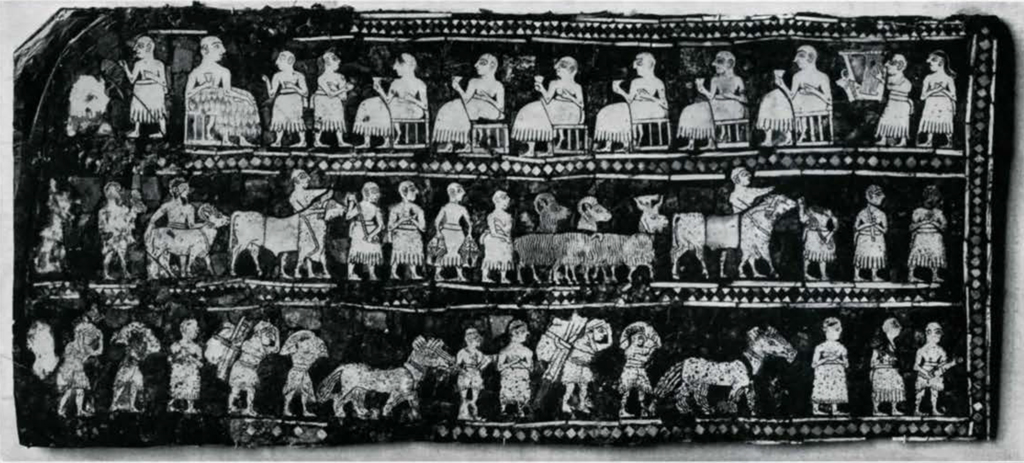
The happy restoration by the British Museum experts of some of the magnificent objects of art taken from the predynastic cemetery at Ur and their recent publication will be welcome to the readers of the JOURNAL. They will admire the stela or standard with six rows of Sumerian figures and scenes of peace and war cut in shell and inlaid on a background of blue lapis; the sounding-box of a harp decorated with inlay, engraved plaques, and a bull’s head in gold and lapis; another bull’s head in gold and lapis, part of a statue or probably of a second harp; finally a rein ring in silver surmounted by a bull mascot from the king’s wagon. In the field of the past, the mist is slowly lifting, leaving a bright golden spot in the muddy plains of Mesopotamia, where Shub-ad was once a queen and Meskalamdug a king in ancient Ur, more than five thousand years ago.
The Inlay Stela
It seems almost impossible ever to satisfy our curiosity by looking at the world of little Sumerian figures crowded in the six registers of the stela and in the two triangular ends. The whole is only 32 inches long, but there is such a variety of action, such a sense of life, with so many different costumes of the king, of his officials and his servants, such a display of arms, cloaks and helmets, such a contrast between the victors and their tattooed enemies, such a fascination about the chariots, their drivers, their men-at-arms, their teams of asses and their harness, that we gaze again and again, afraid to miss a single detail of that wonderful picture of ancient Sumerian life. The king is the real war lord. His figure is drawn on a larger scale and stands in the middle of the upper register. He carries in the right hand a curved club, his sceptre, and in the left, a lance with a large leaf-shaped head. Prisoners are brought one by one to him, and foremost one who is probably the chief of the defeated enemies. The king has alighted from his chariot and is followed by his bodyguard or by officials of high rank, armed with battle-axe and lance. The king, his guard, and his soldiers all wear copper helmets covering the ears and tied with a strap below the chin. Some of the original helmets have been recovered in the excavations and the type strangely recalls some helmets of the crusaders’ time. Lances and axes also have been recovered of the very type represented on the stela. The best gold models must have been the weapons of the king. The proper Sumerian dress is a kilt with long laps, closing behind. Originally a fleece, it may later have been made of woollen material with long thrums woven in on one side in imitation of the fleece. A second piece of the same material—called kaunakes —was thrown like a plaid over the left shoulder. The whole army was shaven and shorn according to Sumerian tradition, and went barefooted, which was no inconvenience on the soft muddy soil of Mesopotamia. Of course a wadded lining was fixed inside the helmet; traces of one have been found inside the golden wig.
The king’s chariot is of the common type of that age, with four wheels, side and back panels, a high front board, and a curved pole rising high and supporting a rein ring behind its junction with the yoke. A diminutive groom, his whip resting on his shoulder, leads the royal team of great mules or asses. The man-at-arms or henchman follows on foot behind, holding the reins in his left and his battle-axe in his right hand. The reins lie in the V-shaped notch cut in the top of the front board. A large quiver full of spare darts and lances hangs on the left horn of the same board. A leopard skin or blanket is thrown over the back panel and covers the step on which the second charioteer will stand during the action, protecting the driver fighting in front. The front board is reinforced by cross pieces, the sides are divided into three panels by straight bars. State chariots decorated with an inlaid pattern of shell and lapis, and lions’, bulls’ and leopards’ heads in gold and silver in the round have been recovered in the royal tombs. These were not war chariots but rather belong to the sumptuous type of coach which Ishtar devised as a reward for her lovers: “I will harness for thee a chariot of lapis and gold, with wheels of gold and horns of diamond. Daily shalt thou harness the great mules.”
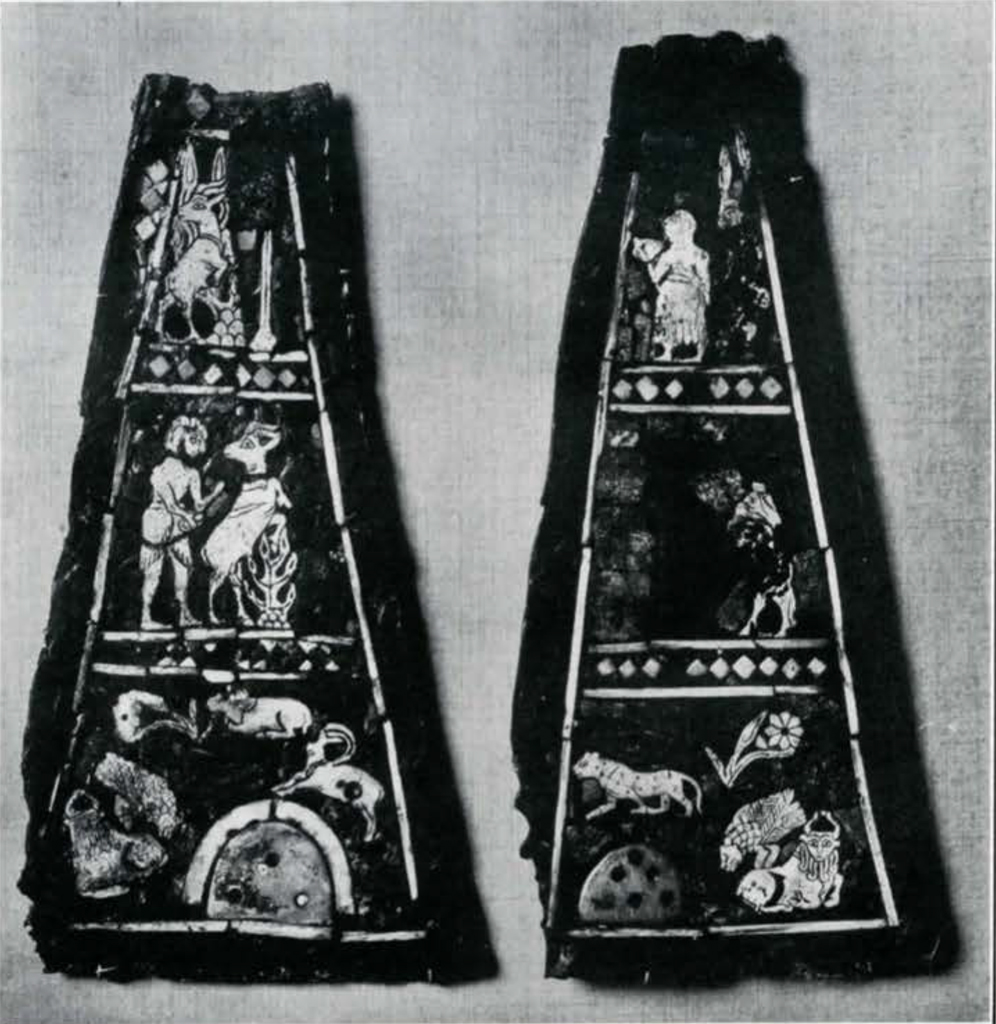
Ishtar herself, the august princess of Uruk, who inhabits a house of gold, drove a team of seven lions. But this is pure mythology. The king’s own team was incontestably a team of four mules or donkeys. For the first time we have a clear, complete picture of the animals with body, hoofs, head, and tail, and they are neither horses nor lions nor bearded bulls nor dragons, but asses, which is very satisfactory. What seems to be the long hair round their necks is neither mane nor beard, but artificial braids of hair or wool attached to the collar like an ornament or to drive flies away, a practice very much in honour among the Assyrians and still observed in many parts of the world. The reins were attached to a ring in the animal’s nose. Silver collars and silver rings have been found in the royal graves, providing evidence that teams of bulls were used as well as teams of asses.
The plain wooden wheels made of two semicircular pieces joined by copper clamps or bands round a central core, have excited the enthusiasm of archaeologists. The wheel, a great human discovery, was in use at Ur more than fifteen hundred years before it was imported into Egypt. There are several models of wheels which show that the central core was either round or lozenge-shaped. The wheel was probably solid with the axle which turned with it in a groove below the body of the chariot. A copper pin or bolt sometimes secured its connection with the axle. In any case the early Sumerian wheel was massive and not yet made more graceful or lighter by the use of spokes. Big knobs of metal sometimes rein-forced the rim. Mr. Woolley has suggested leather tires. The only wheelband discovered at Susa was made of six bronze sections riveted together and forming a complete circle embedded in the rim.
Centuries later Gudea, another prince of Sumer, was ordered to build the royal chariot of his god: “Break the seal (of the doors) of thy treasure house; bring wood out of it, and build a complete chariot for thy king. Harness to it the donkeys. Adorn the chariot with metal and lapis inlay. Darts in the quiver shall shine like the day. Take good care of the ankar , the arm of bravery.” Gudea brought out his most precious timber, esalim-wood, mêsu-wood, huluppu-wood. He completed the chariot and harnessed to it the great Uk-kash donkeys. The chariot shone like the stars in heaven. The donkeys were of the famous breed of Eridu, and the driver Ensignun could drive like a storm. It was an irresistible machine of war: ” The chariot named Kurmugan, was loaded with splendour, covered with brilliancy. With its donkeys, its groom, the seven-headed club, the terrible weapons of the battle, the weapons which no country can resist, the deadly weapons of the battle, the Mi-ib, with a lion head in hulalu stone which no land resists, the sword with the nine emblems, the arm of bravery, the bow which sounds like a (forest), the terrible arrows of the battle which dart like lightnings, the quiver out of which wild beast and dragons let hang their tongues, arms of the battle to fulfil the orders of royalty, all this was a present of Gudea, builder of the temple, patesi of Lagash.”
All the prisoners brought in to the king are nude except the first of them, who wears a short fringed kilt, but he is so indistinct a figure that it is hard to decide whom he represents, probably the enemy king. All have ropes round their necks and their arms tied behind their backs. They are shaven and shorn like their Sumerian opponents and it would have been difficult to distinguish one from another if the enemies did not have marks—war paint or tattoo?—all over the body, on skull, cheek, chest, and thigh. Or are these marks of the wounds inflicted by the battle-axes and lances which we see in the hands of the soldiers, a graphic representation of the blood trickling from the cuts in the flesh? There is a certain freedom of style in that otherwise monotonous procession. Not one figure is the exact copy of the other. The groups are not rigidly the same. Two prisoners are marshalled by one man—if this is the original order? All the soldiers do not carry the same weapon. Their proud attitude, with heads erect, contrasts with the downcast look of the prisoners.
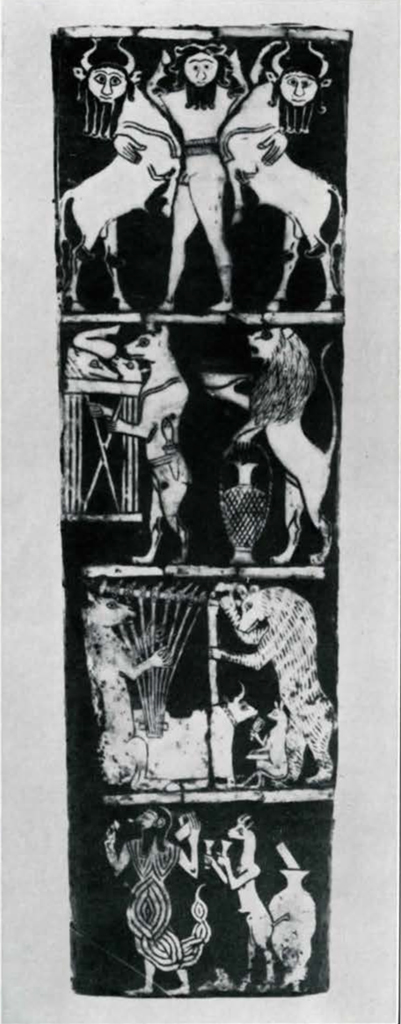
The army in action is displayed in the next two registers. It is divided into two corps, the foot troops and the charioteers. And we cannot help admiring the free imagination, the naive charm in the forceful presentation by the primitive artist of a battle scene so full of life and motion. The solid legion has formed a line with lowered lances pointing forward. All wear the uniform : the scalloped kilt, the copper helmet fixed by a strap under the chin, a mantle covering both shoulders and fastened by a clasp on the chest. The dots in groups of three, four, and five which decorate the mantles make the soldiers look like the pieces of a game of dominoes, giving somehow the impression of knaves in a pack of cards, which would have pleased Alice in Wonderland. In fact these are not dots but the spots of leopard skins, as we see from the animal represented on the triangular end. The skin served as a material for the soldiers’ heavy coat, which was thrown over the back of the chariot when not used, or spread on the seat as a blanket. 3 Nothing could disturb the order of this solid rear line. Their grasp on their lances betokens perfect drilling, and while the practised eye of a sergeant-major might see irregularity in the openings of the mantles, the ordered tramp, tramp of their feet would have swollen with pride the builder of an empire. Three sons of an old Sumerian king on a famous limestone relief 4 wear their mantles in the same manner, fastened with a clasp and covering both shoulders. The soldiers of the front line are already engaged in an action, the issue of which is not doubtful. The enemies are prostrate, wounded, stripped, bound, and captive, so dexterously can the Sumerian warrior handle battle-axe and lance, as shown in three different groups. One prisoner is being handcuffed. The soldier next to him brandishes his lance over a fallen enemy. The third wipes the blade of his axe and feels the cutting edge after dealing a blow. The bodies of the fallen enemies are drawn with much liberty and a daring attempt at perspective and foreshortening of proportions, both here and in the case of the bodies of the enemies run down by the charioteers. The Sumerian soldier in action has discarded his great mantle and thrown his plaid over his left shoulder. A fringed stole over the left arm of one of them is an unusual garment, perhaps the loin cloth of the enemy and a part of the spoil which belongs to the victor. More enemies, nude and wounded, are driven on by the charging infantry. Some of them still keep their lances and their loin cloths closing in front and having narrow fringes. The fight is over and they are fleeing, while one unfortunate man casts a last look on the scene of battle. This part of the stela has evidently suffered and two half figures of men, one nude and the other wearing a loin cloth, have been jumbled together.
The charioteer scene is a pure delight for anybody who has witnessed a charge and the long lines of horses sweeping, wave after wave, through the golden dust. If the first team of asses walks composedly enough, the second has struck a lively pace which becomes a full gallop and a mad dash in the last two. The foremost driver with his goad or two-pronged dart and his henchman brandishing a lance is thrown backwards and the man on the step has to hang on desperately. Their raised heads answer to the raised heads of the animals, to their springing bodies and their flowing tails. Weapons, lances, axes, dresses, helmets, kilts, and plaids are the same as those worn by the infantry. The crumpled nude bodies of the enemies litter the ground.
The reverse is not less interesting. Here we see the pleasures and abundance of peace opposed to the violence of war. The king presides over a banquet amidst his sons or officials and drinks a cup of the best mountain wine. The seats are remarkably elegant. Servants hustle about and a woman singer, we imagine, recites in cadenced verses the great actions of the battle accompanied by the harpist striking in time the eleven cords of his small harp. So the women danced, and sang that King Saul had killed his thousand but David his ten thousand. In the registers below there is a real pageant of servants bringing the requisites of the feast and also the spoils of war. Bulls, goats, a ram, a lamb, and four big carp fresh from the river will supply a royal meal. The safe leading of the lively bulls is no easy matter. A rope is attached to a ring in the beast’s nose, and the first cowboy pulls it high to prevent any unruly tossing, while the second has wound his arms, like a wrestler, round the threatening horns of the bull, ready to throw it. What would our Wild West think of that ancient East? The manner in which the shepherds carry a lamb—or is it a young gazelle?—or hold a ram by the curved horn and fat tail has not changed since those early days. The goat-herd armed with a short stick or a whip drives his animals from behind. For accuracy the heads of the goats nos. 2 and 3 ought to be placed a little forward to balance properly over their forelegs. Goat no. 1 belongs to a different species, the Markhur goat, with spiral horns, long pendent ears, a beard, and a tucked-up tail. A headman carrying his staff of office introduces the procession, which is divided into two main groups headed by figures with clasped hands. These have no special attributes and are perhaps foremen or officials.
In the last register two teams of asses with their drivers, and pack carriers of two types are divided into two or three groups headed by their foremen, if such are the figures with the clasped hands. The first driver walks rope in hand at the head of the procession and evidently ought rather to be placed at the head of his asses, which is his proper station as exemplified by the second driver. One of the pack carriers bears the bundles on his shoulder but the second uses a framework resting on his back and secured by a rope passing round his forehead. This way of carrying heavy burdens strangely recalls Indian basket carriers or jar carriers from old Peru. The carriers and the foremen have long hair, the asses’ drivers are shorn like the rest of the servants above, except the men who bring the lamb and the ram, who wear long hair and beards. This may be a professional as well as a racial distinction. Bedouin shepherds in the desert let their hair grow. But slaves and prisoners of war of different races may have kept their own mode of hairdressing and costume. It is remarkable that all the figures in the last register wear a kilt closing behind or a loin cloth opening in front, with short fringes. The kilt with short fringes is very different from the kilt with long laps worn by the Sumerian officials, or from the better one worn by the king. The loin cloth opening in front is the proper dress of the vanquished enemies. The careful drawing may correspond to a difference in race and rank and also to a difference of material, wool or linen. The only figure—unfortunately incomplete—in the third register who wears the Sumerian kilt with long laps which closes behind, is probably another headman introducing the second procession.
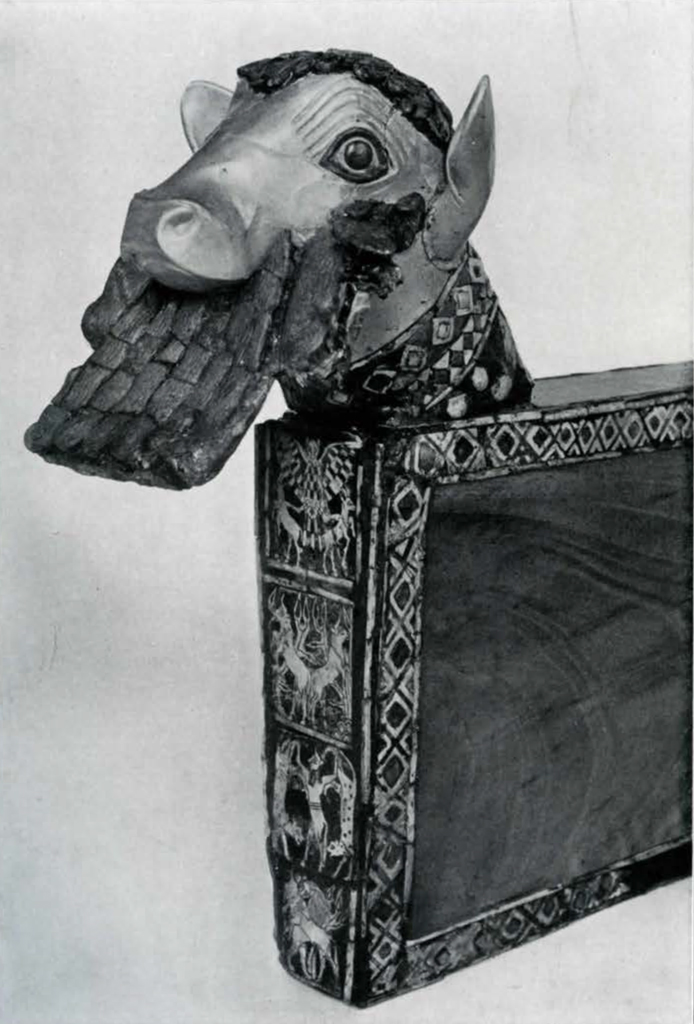
Animal figures borrowed from the common repertory of heraldry and heroic hunting fill the triangular ends of the stela. We have the passant leopard, the couchant lamb, the rampant goat, the conventional branch and star flower with eight petals, in a landscape of hills represented by a pyramid of dots or curves. A hunter, dagger in hand, has seized about the neck a rampant ibex caught amidst bushes and hills. The hunter may be a hillman, an Elamite, with long hair and beard (?), very different from the completely shorn Sumerian. He wears the fringed loin cloth of the enemy, closing in front. The lines of his body are more elongated and graceful, the knees are bare for action. The typical, shorn, stumpy Sumerian wears a bell-shaped woollen kilt closing behind. The long laps hang down the middle of his legs. The panels are reconstructed and the scene is not clear, but he is certainly not a hunter, and is probably raising his hand for some ritual action. The goat rampant amidst bushes and hills with head turned back is probably out of position, and the straight post supporting an emblem 5 is the object which ought to have been placed in front of the Sumerian worshipper. The middle, incomplete panel certainly represented a fight between bull and lion as seen below in the decoration of the harp.
The very ancient mythological group of the lion-headed eagle perched on the back of the bearded, man-headed bison, which he masters and lacerates “unguibus” if not “rostro,” deserves special attention. The composite monsters are in the tradition of archaic Elamite art. The mythical bird is the master of the bull. By no means is he picking off flies and bugs as has been irreverently suggested. The eagle is above all an emblem of royalty, domination, and power, and such has been his meaning through the ages, whether he flies over the heads of Assyrian kings, or before Roman legions, or on Greek, German, French, or American coins. The spread-eagle found in so many coats of arms of old Sumer and of modern countries is the triumphant bird seizing its prey with its talons. He is the emblem of gods of war worshipped in different cities under different names, Ningirsu, Nin-Urash, In-Shusi-nak. Under the name of Imgig he figures in the coat of arms of the city of Lagash, devoted to Ningirsu, where the type of an eagle with a lion’s head is well established and is contemporary with the drawing of many figures in full face. But there was more liberty in the past and we find spread-eagles and eagles in profile, with normal heads and with lions’ heads, capturing two animals or perching on the back of one. Their prey may be bulls, antelopes, lions, stags, ibexes, even ducks.
The bull may be passant, couchant, or rampant. It may be the wild mountain bull with widely spread horns, the primitive urochs, or the bison with crescent horns and long locks, which in old Elamite drawings has tufts of hair below the chin. The last has been transformed into the man-headed bison which has the face of Gilgamesh, before it becomes the bull-man Enkidu. The spread-eagle may even have a double lion’s head, which was a favourite device in the time of Gudea and on a few ancient Elamite seals, but he should not be confused with the birdman Zü, who steals the tablets of destiny, carries the dead bison on his shoulders, has a wife and son, and is killed by Lugalbanda in Khashu, the unknown mountain. Many a seal in the Museum collections represents the capture and judgment of the Zü bird and his disgrace, which can never be imputed to the royal Imgig bird.
The inlay stela, 6 according to Mr. Woolley, is as a work of art unparallelled, as a historic document invaluable. It was found beside the shoulder of a man buried in a side chamber of the oldest of the royal tombs, almost intact as it was executed by the craftsmen of 3500 B.C. It is an elaborate example of inlay work in shell, lapis lazuli, and pink limestone. The two large plaques were set back to back at a slight angle, with the triangular pieces between their ends, and the whole may have been mounted on a pole so as to be carried as a standard. The tesserae had for the most part not shifted from their position. What is shown here is not a reconstruction but the original mosaic. Some of the border has been restored; only the triangular ends had been seriously broken up.
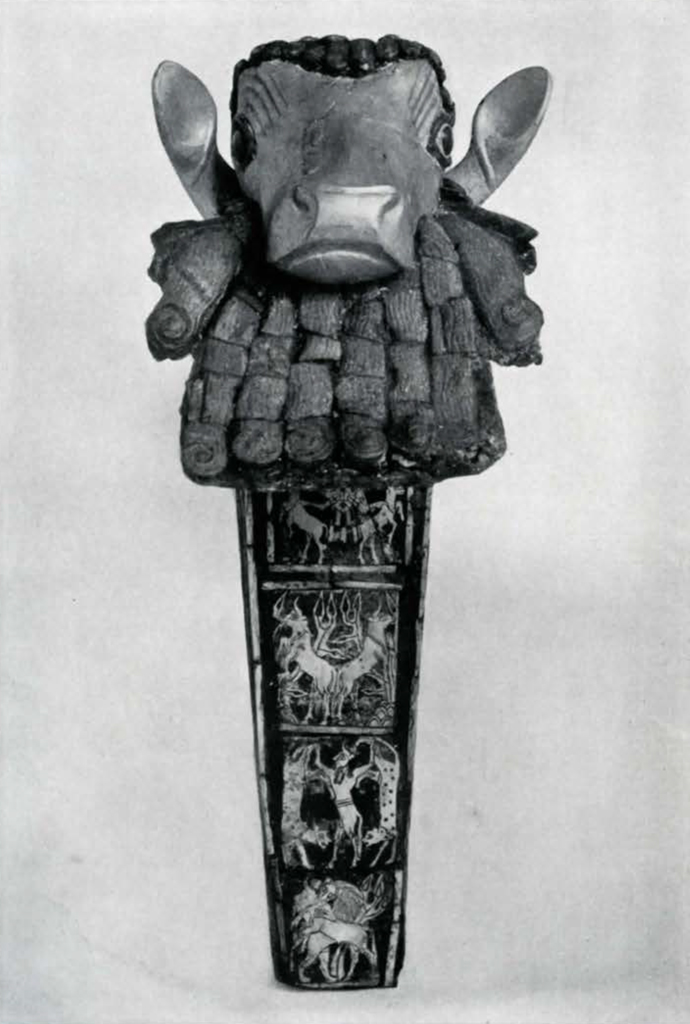
The harp is the instrument of the poets, the support of the aerial words in which they enshrine joys and sorrows, memory of the past and hope immortal. David sang to the harp to soothe the brooding heart of Saul. A harpist and a woman singer stand by at the king’s banquet. Gudea of Lagash presented to his god Ningirsu “his beloved harp named Usumgal-kalamma, the sonorous and famous instrument of his council. The portico (?) of the harp was like a roaring bull.” It served to accompany the sacred prayers which were said in the court, together with the clang of the cymbals. “Along with the flute it filled with joy the courts of the temple.” The temple singer used it “to appease the heart, to please the joyous humour, to wipe tears from the eyes, to release the pain of the suffering heart.” The singer in his recital is likened to “the storm of the Ocean, to the tempest on land, to the soft purifying waters of the Euphrates. The young girls of the harem, the seven twins of the goddess Bau, placed close to him, pronounce the good words. With the flute, the cymbals, and the harp they fill with joy the courts of the temple.”
The harp of Gudea is represented on a limestone relief. It is rectangular in form, with a large sounding-box and an upper bar in which the keys are fixed. It has eleven strings spreading fanwise from the box to the upper bar, towards the left angle behind which sits the player, playing with both hands. A passant bull, probably of gold, stands on the sounding-box, and another bull’s head decorates the front of it.
The little harp represented on the stela also has eleven strings, and is decorated with a bull’s head. The sounding-box has the shape of a couchant bull, with an inlaid collar and an inlaid band across the body. The harpist plays while standing. A band passing over his shoulders may help to carry the instrument. An opening in the sides of the box makes the sounds clearer and mellow.
Another type of harp with eight strings is represented on a shell plaque to be studied below. It is played by a seated donkey and belongs to a very interesting mythological series. With three other plaques it was inset as a decoration below the splendid horned bull’s head in gold, with its large beard of lapis. Bull’s head and plaques were possibly part of a harp of the same type.
The harp found in the queen’s grave had also a sounding-box decorated with a calf’s head of gold and lapis, with shell plaques engraved with mythological subjects, and with bands of inlay. 7 The woodwork, which had perished, has been carefully restored in the British Museum. According to Mr. Woolley the harp has twelve strings, but the position of the keys on the upright is not clear, pending further restoration. The calf’s head and the engraved plaques deserve attention.
The calf’s head, without horns, which decorates the queen’s harp, is made of gold and lapis, like the bull’s head found in the king’s grave, which may also have been part of a harp. Both are wonderful examples of ancient Sumerian art. The same technique was applied to both.
“The head all except the ears and horns was hammered up from a sheet of thin gold and set over a wooden core. The horns and ears made separately were fixed to this. Under the chin a deep cut was made in the wood, the edges of the gold being bent into the cut, and here was inserted the beard. The base of this was a wooden board on which the tresses cut of lapis lazuli were set in bitumen, while the back and sides of the board were concealed by a plate of thin silver seamed by silver nails. The upper part of the woodwork went right up into the wood of the head and was made fast to it by nails driven through the crown. The gold did not cover the crown at all. Here the wooden core left exposed was coated with bitumen and into the bitumen were laid the lapis lazuli locks of hair, each separately carved.
“The eyes of white shell with lapis pupils enclosed in eye sockets of lapis were secured by copper bolts to the wood core of the head. The many superciliary folds are typical of Sumerian art. A strip of gold nailed on behind the horns completed the neck and a narrow band of mosaic in shell and lapis formed a collar to mark the distinction between the metal head and the wooden body.”
These are beautiful pieces of work, curious and refined. The association of full and low relief with engraving betrays the very spirit and taste of ancient Sumerian art. The result of such inlay is very striking. The polychromy of the materials, shell, lapis, gold, red limestone, and bitumen adds new unforeseen effects. The animal forms are heavy but original and powerful. The types, studied from nature in familiar attitudes, are strikingly true. The first sketch fixed the essential forms of each species. The artists of the best periods will have nothing to change to reach perfection, more refinement but not more character.
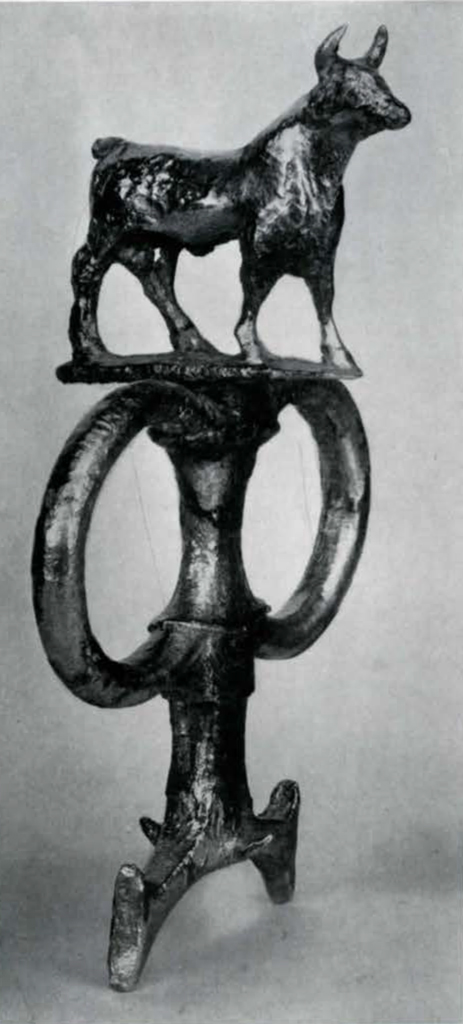
Animal life is a favourite motif of Sumerian art. The animals are drawn in familiar poses, couchant, rampant, running, fighting, according to well-established types. Legendary and fantastic compositions alternate with these monotonous repetitions: lion-headed eagle, bearded bull, scorpion-man.
Sumerian religion gave a large place to spirits, demons, genii, embodying natural forces. This religious and primitive instinct of the race inspired the artists to create monsters, fantastic beings composed of several animal forms, which were sometimes combined with human forms. In Elam long before, when no god had ever been represented as a man, the animals were given strange human attitudes, in an effort to express the mens divinior .
The bearded bison was known to and represented by Elamite artists, with graphic details of locks and tresses, which the wild bull can never claim. But the actual blue lapis beard below the golden head is a human attribute of the hero-hunter Gilgamesh, mighty as Nimrod. The proper attribute of the gods, under human form, is the horned mitre. It is true that the great Moon God of Ur is called the young bull of heaven and his blue lapis beard is famous in religious poems. But the divine harp, Usum-kalamma, roaring like a bull, is not necessarily the great Moon God Nannar or any great bull of heaven.
The front of the harp below the golden calf’s head is decorated with four shell plaques engraved with animal figures, in natural or fantastic composition. Engraving on shell is a purely Sumerian art. The drawing is done with a hard point on dull shell with scarcely visible relief. The plaques of shell of small dimensions were cut from the pivot axis of certain univalve shells of the species trito or melo . Drawing with the point is the most primitive, the simplest, and the most abstract form of art. Bodies are reduced to a single contour line with no thickness. Engraving and drawing are one at first, whether on metal, shell, or mother of pearl. Strength is the ideal of the engraver. His tracing is surprisingly strong, somewhat heavy but full of expression, done with a very accurate hand, but cutting a uniform line. Even inside the contour, the tracing of muscles or the detail of manes and feathers is not a shade lighter. The ambition of the artist is strong uniform work in sharp contrast on the white background. The filling of the lines with black and red paint betrays his delight in life and colours.
Each subject is framed by a straight border line. The intentional order of the figures, the need for symmetry and the heraldic composition of confronted animals is from the beginning the characteristic mark of Sumerian decorative art. Figures en face , always very difficult, and the abundance of minute and systematic details are a daring attempt at reproducing life. There is the same power in the daring attitudes, the heads turned full face, the raised tails, the bristling manes full of a rude energy.
The four subjects selected are the lion-headed eagle seizing two leaping ibexes—or antelopes (?); two bulls rampant in a thicket of plants; the bull-man Enkidu holding up two leopards by their hind legs; a hunting lion at grips with a rampant bull, seizing its neck in its jaws.
The lion-headed eagle alighting on the back of a bull, bearded or not, is one of the strongest motifs in the old Sumerian picture gallery. The same figure in the same angular, rude style is found on several primitive seal cylinders. The spread-eagle is a military emblem on the Stela of the Vultures. The spread-eagle with a lion’s head, seizing in its talons lions, stags, gazelles, bulls, ibexes, or ducks, is one of the fantastic composite animals of the archaic Elamite style. In Sumer it has become a heraldic device, the coat of arms of many war gods, Ningirsu of Lagash, Ninurta, and probably In Shushinak of Susa. His name is the Imgig bird. He is not flying, but has wings spread and flapping in the act of seizing his prey. Pieces representing a feather, cut in red limestone, white shell, and black bituminous stone have been found at Lagash. All are pierced at the back for attachment by copper wire to a wooden board. When assembled they must have formed the wings, body, and tail of the Imgig bird in natural proportions. The red, black, and white must have been contrasted in the checkered lines of colours as represented on the engraved plaque. Separate heads of lions, or of lion-headed eagles in the round, with a mortise for the reception of a tenon at the back must have completed such decoration in the style of the reconstructed Imgig panel of Al ‘Ubaid.
On the engraved plaque the neck of the lion-eagle is short, the ears well developed, the mane figured by three wild locks. The talons are closing on the prey sideways as usual in Elam, and not in front as on the vase of Entemena. The two rampant animals are a species of goat-like antelope like the chamois. It is said that the berkout, the Oriental golden eagle, catches hare, fox, antelope, ibex, wolf, and boar.
The mountain bison with the red thick coat and short, round crescent horns still lives wild in the Caucasus. The urochs with diverging horns from which descend the modern tame cattle is today extinct. It has no beard or locks of hair and is a favourite motif, represented as rampant in a thicket of conventional plants in a landscape of hills. The big buds of the plants sometimes spread into star flowers.
The bull-man Enkidu holding up by the hind leg two leopards is a classical figure of the cycle of the heroic hunters. His counterpart is Gilgamesh holding two leopards by the tail. Eabani is in profile and wears a belt and the beard, locks, and horns of the man-headed bison. The twisted bodies and threatening heads of the enraged animals are remarkable. The strong heraldic symmetry is everywhere prevalent.
The lion attacking the bull is known from other examples which prove the strong school traditions of the Sumerian artist. The lion has stopped the onrushing bull, seized it round the neck, and is biting it in the shoulder. His head is turned full face. The mane is treated in the great, energetic style of Mesilim, back in the time of, if not before, the early kings of Kish.
The Gold and Lapis Bull’s Head
This bull’s head in gold with a beard made of lapis is a magnificent example of the old Sumerian art of the same style as the calf’s head decorating the queen’s harp. It was probably part of another harp, buried in the grave of the unknown king. “A row of engraved shell plaques ornamented the front of the figure set between the legs just below the level of the beard.”
The beard transforms the bull into a legendary animal. The square muzzle regarded en face , the crescent horns with tips of lapis, the large open eyes with superciliary folds, and the quick flapping ears have a superior vigour. We almost expect to hear the bellowing voice.
But the greatest surprise is provided by the four engraved plaques below, unrivalled for the energy and beauty of the drawing, and their richness in mythological subjects. All betray a master hand and a strong Elamite influence, animals playing the parts of men, composite animals given human arms and faces, a scorpion-man, animal musicians of types unknown except on Elamite seal impressions. Gilgamesh en face protecting two man-headed bisons is a classical Sumerian model and the head of the scorpion-man seems to be a copy of the oldest inlaid figures from Kish. The lion rampant may have inspired the carving of the macehead of Mesilim or the engraving on the colossal copper lance from Lagash. But the beautifully shaped jar apparently protected by wickerwork has no parallel outside of Elam. The tracing of the figures is so precise and refined, sober with a gentle charm, that it suggests engraving not so much as painting, such as we expect on Greek vases. But the energetic drawing, the symmetry of subjects, the framing of each panel, and the mythological composition are purely Oriental and Sumerian. The surprise is to find such beautiful works of art at such an early date.
Let us go into details. Gilgamesh, the famous king of Uruk, would be today the perfect athlete. He is the desire of Ishtar, so strong that no wild animal, bull, leopard, or lion, can resist him. The Sumerian artists never tire of representing the hero in close contests with all kinds of rampant or fallen animals. The type of Gilgamesh in full face, with long locks on either side, and the long curls of an imposing beard carefully arranged below his chin, is comparatively recent and betrays a change in manners and school. Older figures of the glorious hunter show him in profile with wild locks and no beard. We know how fond the Sumerians were of soap and razor. Their completely shorn heads are always conspicuous. The beard hanging below clean shaven chin and lips may be an artificial ornament that would go far to explain the lapis beard of the golden bull. It was the current fashion for kings and gods at the time of Urnina and later as seen on the Stela of the Vultures. Wigs may have added a borrowed splendour to bald Sumerian heads, as evidenced by the gold wig of King Meskalamdug. Men with natural short hair and beard, generally servants, shepherds, butchers, masons, musicians, and hunters of the older Elamite type, are represented mingling with shaven Sumerians. We may suspect a mixing of races which must have existed very early in that country. The Sumerian soldiers and the king are all shorn, while their enemies—and some of the servants—have short hair and beard. The confusion begins with the long locks—evidently of a wig—with which they cover their heads even when at war and which make them look like women in the absence of a beard, false or not, or other signs of sex. 8
Hair and beard of Gilgamesh may have been natural. Even in the days of wigs some men used to wear their own hair. But we are evidently on legendary ground, where the hairiness borrowed from kingly state would convey the superhuman strength and dignity of the semidivine hero. The Gilgamesh face with hair and beard is the product of a classical conventional school. The same face has been given to a composite monster famous to the end of the Assyrian empire: the man-headed bison. In exchange the bison’s horns placed on the head of a human king or queen will be a symbol of divinity.
Gilgamesh is nude except for the triple belt with which he has girded his loins.
The second panel represents an extraordinarily interesting ritual scene where the parts of the priest and of the assistant are played by animals. The butcher priest with his knife in his belt who carries the portable altar is a mastiff with a short tail, of the type found on Elamite seal impressions. There also he plays quaintly the part of a shepherd milking a goat from behind, assisted by a fox who holds the goat by beard and horns. The cane (?) altar with uprights reinforced by crosspieces, is of an unusual type not unlike an hour glass. On it are piled choice pieces, a leg of lamb, a calf’s head, and the head of a bear. The dog is given human hands and arms to carry the altar—the Gi-gab Sumerian altar. The knife is a copy of the gold dagger with the lapis handle and the rivets affect the same triangular shape.
The assistant lion is a splendid example of a rampant figure that would grace any coat of arms. The drawing of the old Sumerian artist has fixed forever a classical type rarely surpassed. The treatment of the mane, represented by a series of imbricated tufts of hair of triangular shape, has an archaic vigour also found on old Sumerian works of art, the mace of King Mesilim, the great copper lance of Lagash. The lion carries in his hands a lamp and a jar of wine. The lamp—some original examples in gold and silver have been found in the graves—has that peculiar form evolved from a sea shell, “out of conch cut in two so that the valve at the end might serve as a groove to support the wick.” The jar may have been painted, or more likely was protected by a network of fibre, like the modern Italian fiaschi . It was carried in the same way by a loop of cord attached to the basketwork. Jars of the same type, enigmatically connected with lions or leopards, with a graphic representation of the fiery liquid overflowing are found in the Elamite repertory of seal impressions. The leopard is the familiar animal of Bacchus. The wine instils into men’s hearts the courage of the lion. The mother of King Lemuel used to tell him:
“Give strong drink unto him that is ready to perish, and wine unto those that be of heavy heart.”
There is no ritual sacrifice without ritual music : the sound of the harp and the clanging of the cymbals. Animal musicians fill the next panels. A seated donkey plays on the harp upheld by a bear which one might swear was dancing, if its hands were not so firmly fixed on the frame of the harp. This is friendly and needful aid, since the donkey has both hands and ten extended fingers busy with the strings. The minute tracing of the fingers on either side of the cords is remarkable and in the best tradition of Sumerian art. The head of the donkey is a close study of nature, as are also the other animal figures. The curve of the back is well marked, outlined by the second upright of the harp, which looks like a false tress of hair. The strong strings spread fanlike from the sounding-box to the upper bar, to which they are attached by a double knot. They are eight in number. The slit in the sounding-box, just above the point where they are attached, makes it more resonant. We have seen that the bull’s head, here probably of gold and without beard, is part of the traditional decoration of the harp. Even the rest of the sounding-box affects to copy the body of a couchant bull. A band of inlay separates the metal head from the wood of the box.
The figure of the bear is very unusual, but its rough hair indicated by markings, its short tail and legs, the lump on the shoulders, and the whole bearish attitude of head and arms are very characteristic. No doubt we are to look to the neighbouring mountain land of Elam for its original home, as well as for that of the small animal sitting at its feet, shaking a rattle and drumming on a board. This animal is, as far as we can judge, more like an ichneumon than a monkey. Its connection with the bear and the donkey musicians would delight any folklorist. When first met on Elamite seal impressions it was described as an “unidentified feline species, often seated on its hind legs like a man. It has two small round ears and a sharp nose. Its tail is long and thin. It is represented playing with a small fox and holding it by the tail, catching flies, holding long streamers, or sitting in a boat, oar or harpoon in hand. This animal may be a giant ichneumon or a monkey.” 9 A connection between foxes and musicians, or musicians with a fox’s tail, seems possible in certain Elamite seal impressions.
Finally the scorpion-man strutting in front of a rampant chamois is the most extraordinary figure of the set. Is he supposed to symbolize the wild spirit of the dance, his nipping claws transformed into human arms and hands, his long jointed tail ending in a curled up venomous sting above a pair of human feet, his head with the finely plaited hair and beard of the approved Kish style? The objects in his hands are unfortunately indistinct, but might be prehistoric castanets. Scorpions and tarantulas have always been thought to cause fabulous dancing diseases. The same wild spirit animates the rampant chamois, jumping like the “kids of Engadi.” What seem to be small tumblers in its hands are probably rattles or cymbals. The beautifully shaped high jar at the back with a rectangular piece—or pipe—set at an angle in the mouth probably gives the last touch to a complete picture of a feast with dance and music. Nothing so rich and full of importance for a study of old Sumerian art and history has ever before come out of the field. With the other objects found in the pre-dynastic graves at Ur, these beautiful masterpieces revolutionize our idea of Mesopotamian civilization in the fourth millennium B.C.
As part of a wholesale burial of guards, servants, wives, and singers, in a shaft round the grave of the king, were found two chariots with grooms and teams of oxen. ” Inside the shaft proper, standing as they had been backed down the slope came two wagons, clumsy four-wheeled affairs, each drawn by three oxen. Of the wooden wagon little was found, for wood cannot endure the soil of Ur. The oxen wore wide collars of silver decorated with patterns in repoussé work and had large silver rings in their nostrils. On the reins were strung beads of silver and lapis lazuli and they passed through rein-rings of silver surmounted by a mascot in the form of a bull.” The queen’s chariot had an electrum mascot in the shape of a donkey. 10 A passant lion decorated the pole of the state chariot of Ningirsu, patron god of Lagash.
The Baghdad Museum has claimed as its share the bull mascot. It is a magnificent example of Sumerian art in modelling and casting. Animal figures have always been a favourite subject in Sumer. The wild bull on the glazed bricks of the Ishtar gate is the last beautiful copy of a classical model. The copper bull in the round from Al ‘Ubaid proves how early the Sumerian artist had fixed the characters of a type never surpassed. The short body, the powerful front legs and chest, the raised head and the perfect arc of the horns, the natural attitude of the brute arrested in his walk and full of irresistible strength in its immobility, are a monument to that far back ancestor the Sumerian artist, so close and dear to us for his technical skill, his creative power, and his cult of beauty.
1 Del. 16, p. 2. ↪
2 P. B. S. 14, p. 13. ↪
3 MUSEUM JOURNAL, June, 1927, p. 150. ↪
4 MUSEUM JOURNAL, September. 1926, p. 258. ↪
5 Cf. MUSEUM JOURNAL, June, 1927, p. 150. ↪
6 MUSEUM JOURNAL, March, 1928, pp. 31-33. ↪
7 MUSEUM JOURNAL, March, 1928, pp. 11.-13. ↪
8 MUSEUM JOURNAL, March, 1925, p. 40. ↪
9 Del., t. XVI. p. 22. ↪
10 MUSEUM JOURNAL, March, 1928, pp. 17, 21. ↪
Cite This Article
This digitized article is presented here as a historical reference and may not reflect the current views of the Penn Museum.
Report problems and issues to [email protected] .
4. The Early Middle East
4a. life in sumer.

This beautiful artifact, called by archaeologists “Ram in the Thicket,” was squashed for 4,500 years or so before Sir Leonard Woolley excavated it from the Royal Cemetery at Ur in Mesopotamia. How did he know how to piece it together?
The first writing system. The plow. The sailboat. The first lunar calendar.
These accomplishments and more were the products of the city-states of Sumer, which arose on the flood plains of the Tigris and Euphrates Rivers in what is now modern-day Iraq. The Sumerians began to build their walled cities and make significant advances beginning around 3500 B.C.E.
Their domination of this region lasted until around 2000 B.C.E, when the Babylonians took control. Sumerian culture and technology did not disappear but were adopted by its conquerors.
Located in what the ancient Greeks called Mesopotamia, which literally means “the land between the rivers,” Sumer was a collection of city-states that occupied the southernmost portion of Mesopotamia. Most were situated along the Tigris and Euphrates Rivers, lying just north of the Persian Gulf.

The physical environment there has remained relatively the same since about 8000 B.C.E. The landscape is flat and marshy. The ground is primarily made up of sand and silt, with no rock. The climate is very dry, with only about 16.9 centimeters of rain falling per year. Natural vegetation is sparse, and no trees other than palm trees grow there. The rivers overflow their banks in the spring, sometimes violently and destructively. During this process, they deposit a rich layer of silt on the surrounding floodplain.
The Cradle of Civilization
Considering the harsh and forbidding natural environment, how did the first civilization arise in Sumer? Surprisingly, the environment was part of what made civilization possible.
The silt carried by the rivers down from the northern mountains provided rich fertilizer for growing crops when the rivers overflowed. The constant sunshine was also good for crops. But without water, they would have easily dried up and died. Through the leadership of priest-kings, Sumerians organized farmers in each city-state to build extensive irrigation systems of canals and dams. Before long, the desert was blooming with a surplus of barley, dates, and other crops.
This surplus allowed many people to pursue occupations other than farming, while still being able to meet their basic needs. These people became artisans, merchants, and craftspeople. They helped build the cities and increase the wealth of the city-states through trade with neighboring societies.
Sumerians also developed high-quality crafts, evidence of which was found in the royal tombs of Ur, excavated by Sir Leonard Woolley in the 1920s. Trade also helped the Sumerians to secure vital items such as timber from Lebanon and luxury goods such as the semiprecious stone lapis lazuli from the Indus River Valley.
Gettin’ Ziggy with It

Because of the surplus grain, the government could grow in size to support numerous officials and priests. It could also pay thousands of workers with barley while they were building canals, city walls, and ziggurats or while they were fighting to defend their city-state or extend its influence over the region. The barley was collected as a tax from the farmers. Farmers were also required to give some time to the government to work on projects. Slaves and hired workers also contributed.
As the government and economy grew in size and complexity, officials and merchants required a sophisticated writing system to record transactions. First came number markings and simple pictograms, the writing system began to incorporate pictures representing a physical object or idea (such as a picture of the sun to represent the sun).
As trade and government activity increased, the writing system began to incorporate more abstract pictograms and phonograms, or symbols representing sounds. These new forms provided greater flexibility and speed in writing. They were adopted by other cultures (such as the Assyrians) who did not even speak Sumerian.
Sumerian Wisdom
The Sumerians wrote on clay tablets, using a reed pen called a stylus. Once dried, these tablets became hard and, fortunately for today’s researchers, endured for millennia in the hot, dry climate.
Thousands of these tablets have been unearthed. Some libraries have even been discovered with over 10,000 of these clay tablets. And although the vast majority of these tablets contain records of goods collected and distributed by the governments and trade transactions, some contain myths, stories, and letters. These documents have provided much information about the culture and history of the Sumerian people.
With their ingenuity, the Sumerian people developed complex irrigation system and a written language. They were the first people to use the plow to lift the silt-laden soil of their crop fields and they invented the sailboat. They were the first people to design a calendar based on the phase of the moon and they developed a numerical system, based on the number 60, that is still used to measure seconds and minutes.
The fullest surviving version is derived from twelve stone tablets, in the Akkadian language, which were found stored in the famous library at Nineveh of Assyrian King Assurbanipal.
The epic relates the heroic deeds of Gilgamesh, who is the king of Uruk. His father is mortal and his mother is a goddess. Since Gilgamesh is part mortal, he knows he must die one day. However, he longs for immortality, whether through doing great deeds or discovering the secret of eternal life. He roams the earth on this quest and meets Utnapishtim, the only human granted eternal life by the gods. He tells Gilgamesh many stories, including one of a great flood that covered the Earth.
What happens to Gilgamest? Read the tale and find out. The following is an excerpt from Gilgamesh.
O man of Shuruppak, son of Ubartutu: Tear down the house and build a boat! Abandon wealth and seek living beings! Spurn possessions and keep alive living beings! Make all living beings go up into the boat. The boat which you are to build, its dimensions must measure equal to each other: its length must correspond to its width. Roof it over like the Apsu. From Tablet XI — translation by Maureen Gallery Kovacs, 1998
A culture of many firsts, the Sumerians led the way for other societies that followed them.
- Content created by The Independence Hall Association for ushistory.org under a Creative Commons Attribution 4.0 International License
- Original content contributed by Lumen Learning
If you believe that a portion of this Open Course Framework infringes another’s copyright, contact us .

The Evolution of Sail Boats: Discovering the Inventor and Origins
Alex Morgan

The sailboat, an incredible mode of transportation propelled by the wind, has a rich history that dates back thousands of years. The development of sailboats can be traced through various civilizations and time periods. Let’s explore the history and evolution of sailboats, from their early developments to the modern designs we see today.
Early Developments:
The concept of using sails to harness wind power for navigation has been present since ancient times. Early civilizations such as the Phoenicians, Egyptians, and Mesopotamians made significant contributions to the development of sailing techniques. These early sailboats used simple square sails and were primarily used for river and coastal navigation.
Ancient Egypt and Mesopotamia:
Ancient Egyptians and Mesopotamians were among the first civilizations to use sailboats for trade and transportation. The Nile River in Egypt and the Tigris and Euphrates Rivers in Mesopotamia provided the perfect environments for early sailing vessels to flourish.
Chinese Sailing Innovations:
In ancient China, sailors made remarkable advancements in sailing technology. They developed innovations such as the sternpost rudder, multiple masts, and watertight compartments, which greatly improved the efficiency and stability of sailboats.
Exploration and Trade:
During the Age of Exploration, sailors from different nations set sail on epic voyages, discovering new lands and establishing trade routes. Portuguese navigators, Dutch shipbuilders, and explorers from various countries played a vital role in advancing sailboat design and construction during this era.
Famous Sailboat Inventors:
Throughout history, several notable civilizations and cultures contributed to the invention and evolution of sailboats. Ancient Egyptians were known for their advanced shipbuilding techniques, while the Phoenicians were renowned for their maritime skills and expertise. Chinese inventors also made significant contributions, with their advancements in shipbuilding and navigation techniques. Portuguese navigators, such as Vasco da Gama, made groundbreaking voyages that shaped the future of sailboat travel. The Dutch, with their expertise in shipbuilding, created innovative designs that greatly improved sailing capabilities.
The Evolution of Sailboats:
Sailboats have evolved tremendously over time. From the early square-rigged sails to the introduction of lateen sails, technological advancements improved the efficiency and maneuverability of sailboats. The development of clipper ships in the 19th century led to faster and more efficient long-distance voyages. Today, modern sailboats feature advanced materials, rigging systems, and navigation technologies, making them versatile and capable of various sailing conditions.
As we explore the history and evolution of sailboats, we gain a greater appreciation for the ingenuity and skill of ancient civilizations and the continuous advancements that have shaped the sailboats we know today.
Key takeaway:
- Sail boats have a rich history: The development of sail boats can be traced back to ancient civilizations such as Egypt, Mesopotamia, and China. Exploration and trade played a major role in the advancement of sail boat technology.
- Famous inventors and contributors: Ancient Egyptians, Phoenicians, Chinese inventors, Portuguese navigators, and Dutch shipbuilders all made significant contributions to the invention and evolution of sail boats.
- The evolution of sail boats: From square rigged sails to lateen sails, clipper ships, and modern sail boats, the design and capabilities of sail boats have evolved over time to meet the needs of navigation and exploration.
History of Sail Boats
Take a journey through the captivating history of sailboats as we explore their origins and advancements. From ancient Egypt and Mesopotamia to Chinese sailing innovations, and the era of exploration and trade, each sub-section bears witness to the remarkable development of these majestic vessels. Unveiling early developments and sharing intriguing facts, this section unravels the fascinating tale behind the sailboat’s invention, inviting you to immerse yourself in the rich maritime past.
Early Developments
Early developments in sail boats can be traced back to ancient civilizations such as Egypt , Mesopotamia , and China . These civilizations were pioneers in sail boat construction, making advancements in sail boat technology using wind power and simple square sails on wooden masts for transportation, fishing, and trade. The Egyptians, with their knowledge of wind and water currents, created efficient sail boats that played a crucial role in trade and exploration as they navigated the Nile River and the Mediterranean Sea. The Phoenicians further enhanced sail boat development by introducing multiple masts and triangular lateen sails, improving maneuverability and speed for exploring new territories and expanding trade networks. Meanwhile, ancient Chinese inventors brought innovations such as the stern rudder and watertight compartments to sail boat technology, revolutionizing sail boat design and influencing future maritime technology. These early developments laid the foundation for the evolution of sailing vessels, shaping naval exploration, trade, and transportation. Studying the innovations of ancient civilizations helps us understand the origins of sail boats and their significant impact on human history.
Ancient Egypt and Mesopotamia
Ancient Egypt and Mesopotamia used sail boats for transportation, exploration, and trade. The Egyptians were skilled sailors who utilized wind power to navigate the Nile River and the Red Sea. They could travel longer distances and carry larger quantities of goods.
In Mesopotamia, sail boats were also prevalent. The Sumerians , in particular, were known for their advancements in boat-building techniques. They constructed sail boats with a keel and multiple masts for stability and efficient sailing. These boats were used for transportation and trade along the Tigris and Euphrates Rivers .
The sail boats of Ancient Egypt and Mesopotamia were made from reeds, wood, or papyrus. They used square-rigged sails attached to the mast to harness the wind’s power. These early developments in sail boat technology paved the way for future sailing innovations and exploration.
The advancements made by the ancient Egyptians and Mesopotamians in sail boat design and navigation laid the foundation for seafaring civilizations and expanded trade networks in the ancient world. Their sailing innovations continue to influence modern sail boat designs and maritime traditions.
Chinese Sailing Innovations
The Chinese were pioneers in sailing innovations, introducing various advancements that greatly improved the functionality and safety of sailboats. One of these innovations was the development of stern mounted rudder systems , which replaced the traditional side-mounted steering oars. By incorporating this innovation, Chinese sailors were able to enhance maneuverability and control of their vessels.
Another significant contribution made by the Chinese was the implementation of watertight bulkheads in their sailboats. These compartments divided the hull into separate sections, effectively reducing the risk of sinking in the event of hull damage. The watertight bulkheads not only increased the safety of the sailors but also ensured that the boat remained afloat during voyages, enhancing overall safety at sea.
The Chinese were early adopters of multi-masted ships , utilizing multiple sails and masts to increase the speed and stability of their sailboats. This innovation improved sail handling and overall performance, allowing Chinese sailors to navigate more efficiently through various wind conditions.
Among their impressive advancements, Chinese inventors also developed the magnetic compass . This invention revolutionized navigation at sea, as it provided sailors with an accurate means of determining their direction. With the magnetic compass, Chinese sailors were able to explore new maritime routes and engage in more reliable trade, contributing to the expansion of their maritime empire.
Exploration and Trade
Sail boats played a crucial role in the connection of regions and the facilitation of exploration and trade. They allowed explorers to venture into uncharted waters, expanding their knowledge and discovering new trade routes. The transportation of valuable goods like spices, silk, and precious metals by sail boats contributed to the flourishing of trade. Sail boats aided merchants in establishing trade networks, which resulted in prosperous port cities and trading empires.
Exploration and trade not only influenced economic prosperity, but also led to cultural exchanges that diffused ideas, technologies, and artistic styles. The efficiency and maneuverability of sail boats greatly improved long-distance trade, thereby boosting economic prosperity. During the Age of Exploration , sail boats played a vital role in facilitating exploration by connecting explorers with distant civilizations.
Trade via sail boats faced challenges such as storms, piracy, and unfamiliar waters. Navigational skills and cartographic advancements were crucial in aiding explorers and traders to accurately map their routes. Ultimately, the exploration and trade during this period laid the foundation for the globalization and interconnected world that we live in today. Sail boats revolutionized exploration and trade by connecting people, cultures, and economies globally.
Famous Sail Boat Inventors
From the ancient Egyptians to Dutch shipbuilders, this section delves into the fascinating world of famous sailboat inventors. Discover the innovative contributions of these historical figures as we explore the ingenuity behind their sailboat designs. With each sub-section highlighting a different group of inventors, be prepared to travel through time and across cultures to uncover the remarkable individuals who shaped the evolution of sailboats. Hold on tight as we set sail on this captivating journey of innovation and discovery .
Ancient Egyptians
The Ancient Egyptians played a significant role in sailboat history. They had a deep understanding of sailing and made important contributions to sailboat design and innovation.
The Ancient Egyptians made remarkable contributions to sailboat design and navigation. Their expertise in shipbuilding, use of square rigged sails, and development of papyrus boats greatly influenced the evolution of sailboats throughout history. The legacy of the Ancient Egyptians continues to inspire and inform modern sailboat design and technology.
Phoenicians
The Phoenicians were skilled sailors and shipbuilders who made significant advancements in sail boats. Here are some key points about the Phoenicians and their contributions:
– The Phoenicians established colonies and trading routes in the Mediterranean Sea .
– They built sturdy galleys with multiple rows of oars for propulsion.
– Phoenician ships were constructed using advanced woodworking techniques, enhancing their strength and durability .
– They developed square sails, allowing their ships to sail against the wind by tacking at an angle.
– Steering oars provided greater maneuverability and control.
– Their seafaring skills and knowledge expanded trade networks and cultural influences across the Mediterranean .
Fact: Phoenician ships played a crucial role in spreading their civilization and facilitating the exchange of goods and ideas between civilizations. They were integral to maritime history.
Chinese Inventors
Chinese inventors have made significant contributions to sailboat development. Chinese inventors like Su Song have played a crucial role in advancing sailboats and impacting maritime history. Su Song , an ancient Chinese inventor, improved the sailing compass, aiding accurate navigation. Chinese inventor Zhu Yu revolutionized shipbuilding with watertight compartments, promoting stability and preventing flooding. Another Chinese inventor, Shen Kuo , enhanced sailboat maneuverability with stern-mounted rudders. These inventions by Chinese inventors have enabled exploration and trade.
In addition to sailboats, Chinese inventors like Su Song made strides in other scientific and technological fields during the Song Dynasty, constructing the “Cosmic Engine” clock tower that provided information on celestial observations, weather patterns, and tidal movements. Chinese inventors have played a significant role in shaping the advancements in various areas of innovation.
Portuguese Navigators
The Portuguese navigators played a significant role in the history of sail boats. They were renowned for their exploration and seafaring skills. Portuguese navigators , like Ferdinand Magellan and Vasco da Gama , embarked on daring voyages to find new trade routes. They used sail boats as their primary mode of transportation. Their navigational expertise and advanced shipbuilding techniques allowed them to navigate vast oceans and reach distant lands. Portuguese navigators opened up new trade routes to Asia, Africa, and the Americas. Their contributions to sail boat development revolutionized maritime exploration and trade.
When learning about sail boat history, it’s important to recognize the pivotal role of Portuguese navigators . Their bravery, navigational skills, and shipbuilding techniques paved the way for exploring and colonizing new territories. The voyages of Ferdinand Magellan and Vasco da Gama have left a lasting impact in history. The accomplishments of these Portuguese navigators continue to inspire sailors and explorers across generations.
Dutch Shipbuilders
Dutch shipbuilders played a significant role in the evolution of sail boats. They were innovative and skilled , known for developing the fluyt , a type of sailing vessel commonly used for trade in the 17th century.
These Dutch shipbuilders were experts in constructing efficient, seaworthy, and cost-effective ships. They pioneered new building methods and designs that improved the speed and maneuverability of sail boats. Their expertise allowed them to build ships that could carry larger cargo loads , resulting in increased trade and economic growth.
The influence of Dutch shipbuilders extended beyond their country. Other maritime nations adopted their shipbuilding techniques, further advancing the industry. Dutch ships were sought after and considered some of the world’s finest at the time.
The craftsmanship and innovations of Dutch shipbuilders were crucial in shaping the history of sail boats. Their contributions paved the way for future advancements in shipbuilding technology, making sailing more efficient and accessible for exploration, trade, and transportation .
The Evolution of Sail Boats
As sailboats gracefully navigate across the open waters, it’s fascinating to explore the evolution of these majestic vessels. In this section, we’ll embark on a journey through time and delve into the rich history of sailboats. From the iconic square rigged sails to the innovation of lateen sails, we’ll unearth the stories behind these ingenious designs. We’ll uncover the allure of clipper ships and the advancements that have brought us modern sailboats. Get ready to set sail on a captivating exploration of the evolution of sailboats!
Square Rigged Sails
Passing on the task
Lateen Sails
The lateen sails were an important innovation in sailboat technology. Here are some key points about lateen sails:
– Origin: Developed in ancient Egypt and Mesopotamia, the lateen sails were first used in the Mediterranean.
– Design: Lateen sails are triangular and attach to a long yard or boom. They are rigged at an angle to the mast for better maneuverability and efficiency.
– Advantages: Lateen sails allow sailors to sail closer to the wind and harness wind power more effectively. This enhances maneuverability in narrow waterways and areas with unpredictable winds.
– Wide Usage: Various civilizations, including the Arabs, Persians, Byzantines, and later European sailors during the Age of Exploration, widely adopted lateen sails.
– Trade and Exploration: Lateen sails greatly facilitated trade and exploration, enabling sailors to travel longer distances and reach new destinations.
– Continued Influence: The impact of lateen sails can still be seen in modern sailboat designs, particularly in small recreational boats and traditional dhow sailing vessels in the Middle East.
The development and widespread use of lateen sails had a significant impact on sailboat technology and the history of navigation.
Clipper Ships
Clipper ships were renowned in the 19th century for their sleek and fast sailboats, making them the perfect choice for long-distance trade and transportation. These ships were characterized by three distinct features.
First and foremost, clipper ships boasted narrow and sharp hulls that allowed them to effortlessly slice through the water, resulting in remarkable speed. The hulls were expertly constructed using durable materials such as iron , offering increased resistance against potential damage.
Another noteworthy aspect of clipper ships was their abundance of sails. Equipped with multiple masts, these ships utilized square-rigged sails on the lower masts and fore-and-aft sails on the upper masts, including the iconic “clipper” or “racing” sails. This innovative sail configuration further amplified the ships’ speed and maneuverability by effectively harnessing wind from various angles.
Clipper ships were designed with a relatively smaller cargo capacity . This intentional limitation allowed them to prioritize their primary function of swiftly and securely transporting high-value merchandise like tea, spices, and luxury goods. By carrying lighter loads, these ships maintained their outstanding speed and performance, making them exceptionally well-suited for trade routes with stringent schedules.
Modern Sail Boats
Modern sailboats have advanced in design, technology, and performance. Key features and innovations that characterize modern sailboats include:
1. High-tech materials: Modern sailboats use lightweight and durable materials like carbon fiber and composites, enhancing performance and speed.
2. Sail designs: Advanced computer modeling and design techniques have led to efficient and versatile sails. Sail shapes and sizes can be optimized for different wind conditions, improving speed and maneuverability.
3. Efficient hull designs: Modern sailboats have sleek and streamlined hull designs that minimize drag and resistance, enabling them to glide through the water more efficiently.
4. Hydraulic and electric systems: Many modern sailboats have hydraulic and electric systems that make handling sails and other equipment easier and more efficient. This allows for precise control and adjustment of various sail functions.
5. Advanced navigation and communication systems: GPS, chartplotters, and radar systems have revolutionized navigation on modern sailboats. These systems provide accurate positioning, weather information, and route planning, enhancing safety and efficiency.
6. Integrated safety features: Modern sailboats often come equipped with safety features like man-overboard systems, emergency beacons, and liferafts, ensuring the well-being of crew members during emergencies.
When choosing a modern sailboat, consider factors such as the intended use (racing, cruising, or both), size, and desired performance characteristics. It’s important to find a sailboat that suits your specific needs and preferences.
Some Facts About Who Invented The Sail Boat:
- ✅ The first model of a ship under sail appeared in ancient Mesopotamia between 5500 and 5000 BCE. (Source: Boating Genie)
- ✅ The concept of using a sail likely started as a coincidence when someone held a piece of animal skin up to the wind and noticed it made their raft move faster. (Source: Boating Genie)
- ✅ The boat’s stability became a challenge, which was overcome with the invention of the keel, a flat blade that balanced the boat and prevented capsizing. (Source: Boating Genie)
- ✅ The development of watertight hulls allowed for the construction of larger sailing ships capable of carrying more loads. (Source: Boating Genie)
- ✅ Sailing has played a crucial role in the development of civilization, providing greater mobility for trade, food search, transport, and warfare. (Source: Boating Genie)

Frequently Asked Questions
1. who invented the sailboat and when.
Sailing boats have a long history that dates back to ancient times, but the first sailboat as we know it today appeared in ancient Mesopotamia between 5500 and 5000 BCE.
2. What materials were used to make the sails of early sailboats?
The Egyptians, one of the earliest sailing civilizations, used woven straw, linen, or hemp coated with tar to make the sails of their boats.
3. What was the role of the Water Club of Cork in the development of sailing?
The Water Club of Cork, founded in Ireland in 1720, was the first nautical club. It played a significant role in promoting and advancing sailing, marking the beginning of amateur sailing.
4. How did Chinese junk ships contribute to the history of sailing boats?
Chinese junk ships were highly advanced in terms of size, speed, strength, and maneuverability. They developed important sailing technologies such as mounted steering and the use of triangular sails, which allowed for advanced sailing maneuvers and eliminated the reliance on seasonal winds.
5. Who were the ancient mesopotamians and what was their contribution to sailing?
The ancient Mesopotamians were one of the early civilizations that used sailing boats. They played a crucial role in the evolution of civilization by developing the concept of sailing and building the first model of a ship under sail.
6. Can I experience sailing firsthand by booking a sailing day trip?
Yes, you can book a sailing day trip to experience sailing and enjoy the beauty of being on the water. Many sailing tour companies offer various options for individuals to explore sailing.
About the author
Leave a Reply Cancel reply
Your email address will not be published. Required fields are marked *
Save my name, email, and website in this browser for the next time I comment.
Latest posts

The history of sailing – from ancient times to modern adventures
History of Sailing Sailing is a time-honored tradition that has evolved over millennia, from its humble beginnings as a means of transportation to a beloved modern-day recreational activity. The history of sailing is a fascinating journey that spans cultures and centuries, rich in innovation and adventure. In this article, we’ll explore the remarkable evolution of…

Sailing Solo: Adventures and Challenges of Single-Handed Sailing
Solo Sailing Sailing has always been a pursuit of freedom, adventure, and self-discovery. While sailing with a crew is a fantastic experience, there’s a unique allure to sailing solo – just you, the wind, and the open sea. Single-handed sailing, as it’s often called, is a journey of self-reliance, resilience, and the ultimate test of…

Sustainable Sailing: Eco-Friendly Practices on the boat
Eco Friendly Sailing Sailing is an exhilarating and timeless way to explore the beauty of the open water, but it’s important to remember that our oceans and environment need our protection. Sustainable sailing, which involves eco-friendly practices and mindful decision-making, allows sailors to enjoy their adventures while minimizing their impact on the environment. In this…
- Travel/Study
BIBLE HISTORY DAILY
Uncovering a 4,000-year-old mesopotamian boat.
Ancient boat uncovered from the ruins of Uruk

The Mesopotamian boat of Uruk during excavation. Courtesy German Archaeological Institute.
With archaeologists returning to Iraq, many finds are coming to light, including a 4,000-year-old Mesopotamian boat from the ancient Sumerian city of Uruk. According to a press release by the German Archaeological Institute , the boat was discovered largely intact by a joint German-Iraqi team. The Mesopotamian boat was constructed out of organic materials covered in bitumen, a substance made from crude oil and commonly used for waterproofing across Mesopotamia. This construction technique is similar to that used in the building of Noah’s ark (Genesis 6:14). Since the boat’s burial, however, the organic material has completely decomposed, leaving behind only the outer bitumen cover, which served to preserve the boat’s original shape and size.
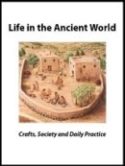
FREE eBook: Life in the Ancient World . Craft centers in Jerusalem, family structure across Israel and ancient practices—from dining to makeup—through the Mediterranean world.
After uncovering the boat, the team set about photographing it and creating three-dimensional models using photogrammetry . The boat measures approximately 23 feet long and 4.5 feet wide. After preliminary studies, the team suggested that the Mesopotamian boat most likely became lodged in the loose soil of the Euphrates riverbank and, over time, was covered with silt and sediment. From the boat’s archaeological context, the team determined that it is likely around 4,000 years old, which would place it toward the end of the Ur III Period (c. 2112–2004 B.C.E.) or the beginning of the Isin-Larsa Period (c. 2004–1763 B.C.E.). Due to fear of additional damage, the team covered the boat in a clay and plaster shell before excavating it completely. The boat is expected to be brought to the Iraq Museum in Baghdad where it will be studied and displayed.

Aerial view showing the outline of the Uruk boat. Courtesy German Archaeological Institute.
Ancient Uruk
The Mesopotamian city of Uruk—Unug in Sumerian—was one of the oldest and most powerful cities in the land of Sumer (southern Iraq). Although in antiquity the city sat along the banks of the Euphrates River, Uruk is now covered in sand, the bed of the Euphrates having long ago shifted its course. The city rose to great power in the fourth millennium and, for a time, it was possibly the largest city in the ancient world. According to the Epic of Gilgamesh , Uruk was also the royal seat of the tale’s eponymous mythical king. As described in the epic (tablet 11), Gilgamesh met an immortal man named Utnapishtim, who had been instructed by the gods to build a giant circular boat to save himself from a flood that would be sent by the gods. In the 1800s, scholars proposed that Uruk could be the biblical city of Erech, the second city built by Nimrod in Genesis 10:10.
Read more in Biblical Archaeology Daily:
The Rebirth of Archaeology in Iraq
How Did Noah Build the Ark?
All-Access members, read more in the BAS Library:
The Galilee Boat—2,000-Year-Old Hull Recovered Intact
Was Noah’s Ark a Sewn Boat? Not a BAS Library or All-Access Member yet? Join today.
Related Posts
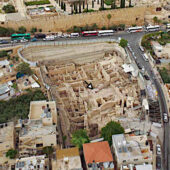
Biblical “Chamber” Identified in Jerusalem?
By: Marek Dospěl

Digitizing Ancient Seals
By: Elizabeth Knott

How Was Jesus’ Tomb Sealed?
By: Megan Sauter

Excavating Jerusalem with Cosmic Rays
By: Nathan Steinmeyer
Write a Reply or Comment Cancel reply
Your email address will not be published. Required fields are marked *
Recent Blog Posts

Seth in the Bible

Fruit in the Bible

Pleistocene Paradise

If I Ascend to Heaven … Paul’s Journey to Paradise
Must-read free ebooks.
50 Real People In the Bible Chart
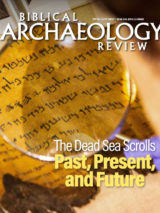
The Dead Sea Scrolls: Past, Present, and Future

Biblical Peoples—The World of Ancient Israel

Who Was Jesus? Exploring the History of Jesus’ Life
Want more bible history.
Sign up to receive our email newsletter and never miss an update.
By submitting above, you agree to our privacy policy .
All-Access Pass
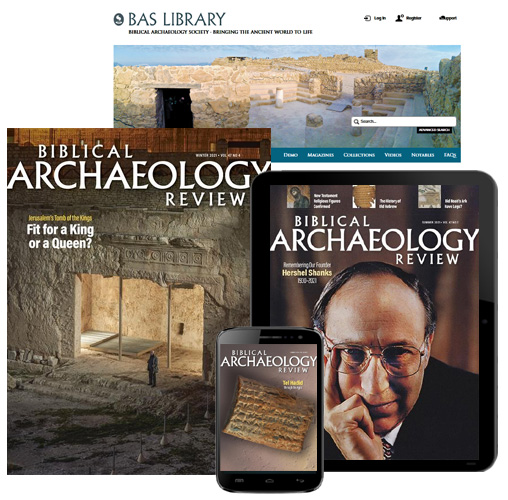
Dig into the world of Bible history with a BAS All-Access membership. Biblical Archaeology Review in print. AND online access to the treasure trove of articles, books, and videos of the BAS Library. AND free Scholar Series lectures online. AND member discounts for BAS travel and live online events.
Signup for Bible History Daily to get updates!
Academia.edu no longer supports Internet Explorer.
To browse Academia.edu and the wider internet faster and more securely, please take a few seconds to upgrade your browser .
Enter the email address you signed up with and we'll email you a reset link.
- We're Hiring!
- Help Center

Mesopotamian Ancient Basket Weaving Technology and the Sumerian Reed Industry

#1. Neolithic technology, especially technology involving the use of reeds and weaving, was highly advanced long before the beginning of Sumerian civilizations. Many of these technologies were based on 'basket weaving technology' and were involved in the creation of a wide variety of products from bitumen treated basket-buckets used in irrigation to large reed ships. #2. These advanced Neolithic technologies formed the bedrock, the foundation, for the emergence of these civilizations. These technologies were crucial, for example, to the development of irrigation and dredging the canals. #3. When more advanced technologies appeared such as copper, bronze, and fired bricks (many treated with bitumen), the earlier technologies played a supporting role and were involved in their development and their production. #4. Although new technologies emerged, they did not entirely replace the older technology which continued to be used in a variety of roles both traditional and in support of the new technologies. #5. There have been many misconceptions about the rise of civilization in Mesopotamia which has made it hard to grasp the 'big picture'. Housing made of reeds, for example, may have been much more widespread than previously thought and a huge fleet of reed boats and coracles made with reeds may have been as important, if not more important, than the large wooden ships that were developed to haul heavy cargoes and to import goods from distant ports. In addition, there was an extensive reed industry that existed from Neolithic times and continued with the Sumerian civilizations but this industry has not been properly identified.
Related Papers
The rise of the world's first civilization, that of Sumer in Mesopotamia, could not have occurred without a fully developed basket weaving technology that was available from the beginning. This technology may have reached a high point thousands of years earlier as shown by the Ain Ghazal statues which had a sophisticated woven reed core. While this was not the only developed technology at the time, it was crucial. In this article, I make two main points. #1. There is now clear physical evidence of basket weaving technology or reed craftsmanship (as the Sumerians also called it) long before the start of the Sumerian civilization. I list three examples of this evidence. #2. The Sumerians were able to use their highly developed reed craftsmanship to establish the world's first civilization in part because of their weaving skills and because they had access to an unlimited number of reeds, plus mud, clay, and bitumen. In this article, I cite numerous studies and experts to further my argument. I cover sea-going reed ships, irrigation, agriculture, home building, mass-produced bricks, the importation of copper, and more. I also include an appendix in which I list more than 100 words relating to basket weaving technology, words that were used for thousands of years in Mesopotamia, indicating the importance of this technology.
Sebastian Fink
It is clear from the fact that pottery had not been invented until late in the Neolithic era, that other tools and implements must have been fabricated during the Pre-Pottery Neolithic (PPN). Serge Svizzero points out in his quoted article that agriculture would have required a necessary set of support tools and containers to be successful; it is not enough to say that the Neolithic way of life occurred because of agriculture and the domestication of animals. In this article, I present direct and indirect evidence of Neolithic basketry to show that many of these implements could have been made using woven-fiber technology or basket weaving skills, a technology that may have been passed down from Upper Paleolithic societies. And I suggest these skills continued to be employed all during the Neolithic time period. Furthermore, I suggest these skills were passed on to the emerging civilizations in Mesopotamia and Egypt who made full use of this technology when needed.
Harshvardhan Kothari
eloisa Casadei
Nur Mohammad`Babu
Daniela Arroyo Barrantes
John Whittaker , Patricia C. Anderson
Textile Terminologies from the Orient to the Mediterranean and Europe, 1000 BC to 1000 AD
Louise Quillien
RELATED TOPICS
- We're Hiring!
- Help Center
- Find new research papers in:
- Health Sciences
- Earth Sciences
- Cognitive Science
- Mathematics
- Computer Science
- Academia ©2024
Please enable JavaScript in your web browser to get the best experience.
91 related objects
Amulet ; statuette ; figurine, cylinder seal, dedicatory cone, figure ; votive offering.

Hand-Picked Top-Read Stories

Priest Bill Bean: ‘I was abducted by skinny aliens with very long fingers,’

Alien Encounter of Megan Liker: Gave Birth To 48 Alien Babies

Are Shivlinga’s Ancient Nuclear Reactors? The Debate Over Ancient Aliens in India
Trending tags.
- zpombie deers
- zoo Hypothesis
- zone of silence
- zombies virus
- Zombies In Haiti
- zombie virus
- zombie meat

From Wheels To Lunar Calendar: Exploring The Incredible Sumerian Inventions That Transformed The World
The ancient civilization of Sumer, located in Mesopotamia (modern-day Iraq) between the Tigris and Euphrates rivers, was a cradle of human civilization. The Sumerians , who thrived over 4,000 years ago, left behind an extraordinary legacy. The Sumerians were a people of great ingenuity and resourcefulness. Their thirst for knowledge led them to create inventions that pushed the boundaries of what was possible at the time. Their contributions covered a vast array of fields, including agriculture, mathematics, astronomy, writing, and more. The Sumerians established the first known civilization, and their inventions were crucial to their success and longevity. This article explores some of the incredible Sumerian inventions that played a transformative role in shaping our world.

Table of Contents
Sumerian Invention Of The Code of Ur-Nammu: Early Legal Framework
The Sumerians are credited with the invention of one of the earliest known legal codes, the Code of Ur-Nammu . This legal framework, established by King Ur-Nammu of Ur, provided a set of laws and regulations that governed various aspects of Sumerian society . It represents a significant milestone in the development of legal systems and the concept of justice. The Code of Ur-Nammu consisted of a series of laws that covered a wide range of subjects, including criminal offenses, property rights, family matters, and commercial transactions. It aimed to establish order, resolve disputes, and maintain social harmony within Sumerian city-states.

The code prescribed specific punishments for different offenses, emphasizing fairness and proportionality. The Sumerian invention of the Code of Ur-Nammu signifies the Sumerians’ intellectual advancements and their commitment to establishing a just society. It serves as an important milestone in the development of legal frameworks and highlights the enduring significance of law in human civilization. The Code of Ur-Nammu stands as a testament to the Sumerians’ early understanding of the importance of codifying laws and ensuring the equitable functioning of society.
Sumerian Invention Of The Lunar Calendar: Tracking The Celestial Cycles
The Sumerians developed the lunar calendar by observing the moon’s phases , revolutionizing time measurement. This calendar, based on lunar cycles, guided agricultural activities, religious observances, and celestial navigation. Its influence spread to future civilizations and continues to shape modern calendars.

The Sumerian invention of the lunar calendar stands as a testament to their keen observation skills and enduring impact on timekeeping. It represents a significant milestone in the measurement and organization of time, providing a foundation for calendars that continue to be used today. The Sumerians’ pioneering efforts in creating the lunar calendar highlight their quest for understanding and their profound influence on the development of human civilization.
Sumerian Invention Of Monarchy: Pioneering The Concept Of Rulership
The Sumerians introduced monarchy, establishing centralized governance with a single ruler. This innovation brought stability, efficient decision-making, and the development of laws. Their invention influenced future civilizations, shaping the course of political systems. The Sumerian invention of monarchy stands as a testament to their organizational prowess and its lasting impact on governance.

It represented a shift in power dynamics, laying the groundwork for the consolidation of authority and the establishment of centralized states. The Sumerians’ pioneering efforts in monarchy remain an enduring legacy in the evolution of governance and the shaping of human societies.
Copper Fabrication: A Sumerian Technological Marvel
The Sumerians excelled in copper fabrication , revolutionizing tool-making and shaping their society. They discovered that combining copper with tin created bronze, a stronger alloy. This breakthrough led to improved agricultural tools, formidable weapons, and exquisite craftsmanship. The Sumerians’ mastery of copper fabrication had a lasting impact, spreading their knowledge and shaping the Bronze Age in neighboring civilizations.

Their technological achievements propelled economic prosperity, cultural exchange, and set the stage for future advancements in metalworking. The Sumerians’ ingenuity in copper fabrication stands as a testament to their enduring legacy as pioneers of technological progress.
Sumerian Invention Of Time: A Revolutionary Concept
The Sumerians introduced the concept of time measurement. By dividing the day into smaller units, they brought order and efficiency to daily life. Their invention laid the foundation for precise timekeeping, calendars, and mathematical advancements. his groundbreaking system not only brought order to their daily lives but also allowed them to plan their tasks with greater precision.

Whether it was tending to agricultural activities, engaging in trade, or conducting administrative affairs, the Sumerians now had a means to navigate the ebb and flow of time. The Sumerians’ revolutionary concept of time continues to shape our world today.
Sumerian Invention Of The Wheel: A Revolutionary Advancement
The Sumerians introduced the wheel, a groundbreaking invention that transformed transportation and trade. Their solid wooden wheels revolutionized carts and chariots, enhancing the movement of goods and people. The wheel’s impact on agriculture, industry, and global civilization cannot be overstated. It facilitated the transportation of goods over long distances, opening up new avenues for economic exchange.

The Sumerians developed trade networks that spanned vast territories, enabling the exchange of goods, ideas, and cultural influences. The wheel became the cornerstone of their economic prosperity and contributed to the growth and development of their civilization. The Sumerian invention of the wheel stands as a testament to their ingenuity and has left an indelible mark on human progress.
Sumerian Invention Of The Numeral System: A Revolutionary Mathematical Breakthrough
The Sumerians invented a numerical system based on a base-60 system known as sexagesimal. This innovative system revolutionized mathematics, enabling advanced calculations and influencing numeral systems still in use today. It facilitated precise measurements, influenced written language, and spread to neighboring civilizations. The Sumerian numeral system stands as a testament to their mathematical achievements and its lasting impact on human civilization. The influence of the Sumerian numeral system extended far beyond their own civilization.

The concept of a base-60 numerical system spread to neighboring regions and subsequent civilizations, including the Babylonians and the Greeks. The legacy of the Sumerian numeral system can be seen in our modern measurement of time (60 seconds in a minute, 60 minutes in an hour) and angles (360 degrees in a circle), as well as in the continued use of the sexagesimal system in various fields of study.
Sumerian Invention Of Board Games: Ancient Entertainment And Strategic Thinking
The Sumerians can be credited with inventing one of the earliest forms of board games. These games served as both entertainment and a means of developing strategic thinking skills, showcasing the Sumerians’ ingenuity and their appreciation for intellectual pursuits. The Sumerian board games were typically played on a flat surface with various game pieces or tokens. These games involved elements of strategy, chance, and competition, providing players with an engaging pastime. They were not only sources of amusement but also platforms for honing decision-making, problem-solving, and strategic planning abilities.

The Sumerian invention of board games showcases their creativity and their desire for intellectual stimulation. These games served as a source of enjoyment and as a platform for the cultivation of strategic thinking skills. The legacy of Sumerian board games reminds us of the timeless appeal of engaging in friendly competition and the enduring impact that simple yet profound inventions can have on human entertainment and social interaction.
Sumerian Invention Of Weapons: Pioneers In Warfare
The Sumerians were pioneers in weapon development, crafting a range of innovative tools for warfare. Their mastery of materials like copper and bronze resulted in formidable weapons such as spears, daggers, axes, and composite bows. These advancements revolutionized combat and influenced military strategies for generations to come. The Sumerians’ ingenuity in weapon invention remains a testament to their military prowess and impact on human history.

As we consider the Sumerian invention of weapons, we recognize their lasting impact on human history. The advancements made by the Sumerians in weaponry not only shaped the ancient world but also laid the groundwork for future developments in warfare. The Sumerians’ pioneering spirit in weapons technology serves as a reminder of the pivotal role that innovation and ingenuity play in shaping the course of human civilization.
Sumerian Invention of Sailboats: Harnessing The Power Of The Wind
The Sumerians invented sailboats, utilizing wind power for navigation. These innovative vessels transformed maritime travel, facilitating trade and exploration. By harnessing the wind’s energy, the Sumerians expanded their reach and established connections with distant cultures. Their invention laid the foundation for future advancements in sailing technology and remains a testament to their pioneering spirit.

As we reflect on the Sumerian invention of sailboats, we acknowledge their significant contribution to the field of navigation and the exploration of the world’s oceans. The sailboat remains a symbol of human innovation and the indomitable spirit of exploration. The Sumerians’ pioneering efforts in sailboat technology have left an indelible mark on human history, shaping the course of seafaring and serving as a testament to the enduring power of human ingenuity.
The Enduring Legacy of Sumerian Inventions
The Sumerians stand as trailblazers in the realm of invention and innovation. Sumerian inventions across various fields have left an indelible mark on human civilization. From the practicality of copper fabrication and the revolutionary concept of the wheel to the intellectual pursuits of time measurement, numeral systems, and legal frameworks, the Sumerians were visionaries ahead of their time.
Their inventions not only improved daily life but also shaped the trajectory of human progress. The Sumerians’ ability to harness natural resources and their keen observation of the world around them allowed them to develop groundbreaking technologies and systems that would set the stage for future advancements.
Beyond their practical inventions, the Sumerians fostered a spirit of exploration and intellectual curiosity. Their sailboats opened new horizons, their lunar calendar tracked celestial cycles, and their board games provided entertainment and strategic thinking challenges. These endeavors highlight the Sumerians’ holistic approach to innovation, encompassing both practical and intellectual pursuits.
The influence of the Sumerian inventions extended far beyond their own civilization. Their ideas and technologies spread, shaping the development of subsequent societies and becoming foundations upon which further progress was built.
As we reflect on the Sumerians’ remarkable legacy, we are reminded of the power of human ingenuity and the transformative impact of innovation. The Sumerians’ inventions have stood the test of time, leaving an enduring imprint on the course of human history. Their pioneering spirit and relentless pursuit of knowledge continue to inspire us to push the boundaries of what is possible and to strive for progress in all aspects of life.
The Sumerians’ legacy serves as a testament to the boundless potential of human creativity and the everlasting impact that inventive thinking can have on shaping the world. As we navigate the future, let us draw inspiration from the Sumerians’ innovative spirit and embrace the challenge of pushing the boundaries of knowledge and invention.
Leave us your thoughts in the comment section.
Share this:
- Sumerian Inventions
Leave a Reply Cancel reply
Your email address will not be published. Required fields are marked *
Save my name, email, and website in this browser for the next time I comment.
Notify me of follow-up comments by email.
Notify me of new posts by email.
Yes, add me to your mailing list.
Sign Up for Our Newsletters
Previous post.

Actor Yaphet Kotto Who Acted In 1979 Movie ‘Alien,’ Has Been Encountering Aliens In Real Life

Super Human Ability Of Benedetto Supino: Italian Boy Who Could Set Things On Fire By Staring At Them
Related posts.

- Archaeology
Ancient Biblical And Sumerian Texts Prove That Aliens Created Humans
Pentagon reveals that UFOs are not of this world and they possess physical evidence of this

Secret CIA Unit Took Possession of 9 Alien Ships Of Which 2 Were Intact
- History Classics
- Your Profile
- Find History on Facebook (Opens in a new window)
- Find History on Twitter (Opens in a new window)
- Find History on YouTube (Opens in a new window)
- Find History on Instagram (Opens in a new window)
- Find History on TikTok (Opens in a new window)
- This Day In History
- History Podcasts
- History Vault
By: History.com Editors
Updated: June 6, 2023 | Original: December 7, 2017

Sumer was an ancient civilization founded in the Mesopotamia region of the Fertile Crescent situated between the Tigris and Euphrates rivers. Known for their innovations in language, governance, architecture and more, Sumerians are considered the creators of civilization as modern humans understand it. Their control of the region lasted for short of 2,000 years before the Babylonians took charge in 2004 B.C.
Sumerian Civilization
Sumer was first settled by humans from 4500 to 4000 B.C., though it is probable that some settlers arrived much earlier.
This early population—known as the Ubaid people—was notable for strides in the development of civilization such as farming and raising cattle, weaving textiles, working with carpentry and pottery and even enjoying beer. Villages and towns were built around Ubaid farming communities.
The people known as Sumerians were in control of the area by 3000 B.C. Their culture was comprised of a group of city-states, including Eridu, Nippur, Lagash, Kish, Ur and the very first true city, Uruk. At its peak around 2800 BC, the city had a population between 40,000 and 80,000 people living between its six miles of defensive walls, making it a contender for the largest city in the world .
Each city-state of Sumer was surrounded by a wall, with villages settled just outside and distinguished by the worship of local deities.
Sumerian Language and Literature
The Sumerian language is the oldest linguistic record. It first appeared in archaeological records around 3100 B.C. and dominated Mesopotamia for the next thousand years. It was mostly replaced by Akkadian around 2000 B.C. but held on as a written language in cuneiform for another 2,000 years.
Cuneiform, which is used in pictographic tablets, appeared as far back as 4000 B.C., but was later adapted into Akkadian, and expanded even further outside of Mesopotamia beginning in 3000 B.C.
Writing remains one of the most important cultural achievements of the Sumerians, allowing for meticulous record keeping from rulers down to farmers and ranchers. The oldest written laws date back to 2400 B.C. in the city of Ebla, where the Code of Er-Nammu was written on tablets.
The Sumerians were considered to have a rich body of literary works, though only fragments of these documents exist.
Sumerian Art and Architecture
Architecture on a grand scale is generally credited to have begun under the Sumerians, with religious structures dating back to 3400 B.C., although it appears that the basics of the structures began in the Ubaid period as far back as 5200 B.C. and were improved upon through the centuries. Homes were made from mud bricks or bundled marsh reeds. The buildings are noted for their arched doorways and flat roofs.
Elaborate construction, such as terra cotta ornamentation with bronze accents, complicated mosaics, imposing brick columns and sophisticated mural paintings all reveal the society’s technical sophistication.
Sculpture was used mainly to adorn temples and offer some of the earliest examples of human artists seeking to achieve some form of naturalism in their figures. Facing a scarcity of stone, Sumerians made leaps in metal-casting for their sculpture work, though relief carving in stone was a popular art form.
Under the Akkadian dynasty, sculpture reached new heights, as evidenced by intricate and stylized work in diorite dated to 2100 B.C.
Ziggurats began to appear around 2200 B.C. These impressive pyramid-like, stepped temples, which were either square or rectangular, featured no inner chambers and stood about 170 feet high. Ziggurats often featured sloping sides and terraces with gardens. The Hanging Gardens of Babylon was one of these.
Palaces also reach a new level of grandiosity. In Mari around 1779 B.C., an ambitious 200-room palace was constructed.

Sumerian Science
Sumerians had a system of medicine that was based in magic and herbalism, but they were also familiar with processes of removing chemical parts from natural substances. They are considered to have had an advanced knowledge of anatomy, and surgical instruments have been found in archeological sites.
One of the Sumerians greatest advances was in the area of hydraulic engineering. Early in their history they created a system of ditches to control flooding, and were also the inventors of irrigation, harnessing the power of the Tigris and Euphrates for farming. Canals were consistently maintained from dynasty to dynasty.
Their skill at engineering and architecture both point to the sophistication of their understanding of math. The structure of modern time keeping, with sixty seconds in a minute and sixty minutes in an hour, is attributed to the Sumerians.
Sumerian Culture
Schools were common in Sumerian culture, marking the world’s first mass effort to pass along knowledge in order to keep a society running and building on itself.
Sumerians left behind scores of written records, but they are more renowned for their epic poetry, which influenced later works in Greece and Rome and sections of the Bible , most notably the story of the Great Flood, the Garden of Eden, and the Tower of Babel. The Sumerians were musically inclined and a Sumerian hymn, “Hurrian Hymn No. 6,” is considered the world’s oldest musically notated song.
The very first ruling body of Sumer that has historical verification is the First Dynasty of Kish. The earliest ruler mentioned is Etana of Kish, who, in a document from the time, is credited as having “stabilized all the lands.” One thousand years later, Etana would be memorialized in a poem that told of his adventures in heaven.
The most famous of the early Sumerian rulers is Gilgamesh, king of Uruk, who took control around 2700 B.C. and is still remembered for his fictional adventures in the Epic of Gilgamesh , the first epic poem in history and inspiration for later Roman and Greek myths and Biblical stories.
A devastating flood in the region was used as a pivotal point in the epic poem and later reused in the Old Testament story of Noah.
Sumerian Power Struggles
Somewhere around 2600 B.C., a power struggle erupted between the leaders of Kish, Erech and Ur, which set off a “musical-chairs” scenario of rulers for the region for the next 400 years.
The first conflict resulted in the kingdom of Awan seizing control and shifting the ruling body outside of Sumer until the kingship was returned to the Kish.
The Kish kept control briefly until the rise of Uruk King Enshakushanna, whose brief dynasty was followed by Adabian conqueror Lugalannemundu, who held power for 90 years and is said to have expanded his kingdom up to the Mediterranean. Lugalannemundu also conquered the Gutian people, who lived in the Eastern Iraqi mountains and who would later come to rule Sumer.
In 2500 B.C. the only woman to rule the Sumerians, Kubaba, took the throne. She is the only female listed on the Sumerian King List, which names all rulers of Sumer and their accomplishments. Kubaba’s son, Puzur-Suen, eventually reigned, bringing in the fourth dynasty of Kish, following a brief ascendency of Unzi, the first in the Akshak Dynasty.
This last Kish dynasty ruled for a century before Uruk king Lugal-zage-si ruled for 25 years before Sargon took control in 2234.
Sargon was an Akkadian whose past is shrouded in legends that some claim were ignited by Sargon himself. The claim is that he was the secret child of a high priestess who placed him in a basket and cast him off into a river, a story that was later utilized for Moses in the Old Testament .
Sumerian tradition says that Sargon was the son of a gardener who rose to the position of cupbearer for Ur-Zababa, king of Kish, which was not a servant position but a high official.

Ur-Zababa was defeated by the king of Uruk, who was, in turn, overtaken by Sargon. Sargon followed that victory by seizing the cities of Ur, Umma and Lagash, and establishing himself as ruler. His militaristic reign reached to the Persian Gulf.
Sargon built the city of Agade as his base, south of Kish, which became an important center in the ancient world and a prominent port. Agade was also home to Sargon’s army, which is considered the first organized standing army in history and the earliest to use chariots in warfare.
Sargon took control of the religious cultures of the Akkadians and the Sumerians, making his daughter Enhedu-anna the head priestess of the moon god cult of Ur. Enheduanna is best remembered for her transcriptions of temple hymns, which she also wrote and preserved in her writings.
Sargon ruled for 50 years, and after his death, his son Rimush faced widespread rebellion and was killed. Rimush’s brother Manishtushu met the same fate.
Sargon’s grandson, Naram-Sin, took the throne in 2292 B.C. Naram-Sin considered himself divine and was leveled with charges of sacrilege.
The Gutians invaded in 2193 B.C. following the reign of the last Akkadian king, Naram-Sin’s son Sharkalisharri. Their era is marked by decentralized chaos and neglect. It was during Gutian reign that the grand city of Agade decayed into wreckage and disappeared from history.
The final gasp of Sumer leadership came in 2100 B.C. when Utuhegal, king of Ur, overthrew the Gutians. Utuhegal’s reign was brief, with Ur-Nammu, the former governor of Ur, taking the throne, starting a dynasty that would rule for about a century.
Ur-Nammu was known as a builder. Figurines from the time depict him carrying building materials. During his reign, he started massive projects to build walls around his capital city, to create more irrigation canals, construct new temples and rebuild old ones.
Ur-Nammu also did the considerable work of constructing an organized and complicated legal code that is considered the first in history. Its purpose was to ensure that everyone in the kingdom, no matter what city they lived in, received the same justice and punishments, rather than rely on the whims of individual governors.
Ur-Nammu also created an organized school system for state administrators. Called the Edubba, it kept an archive of clay tablets for learning.

What Happened to Sumer?
In 2004 B.C., the Elamites stormed Ur and took control. At the same time, Amorites had begun overtaking the Sumerian population.
The ruling Elamites were eventually absorbed into Amorite culture, becoming the Babylonians and marking the end of the Sumerians as a distinct body from the rest of Mesopotamia.

HISTORY Vault: Ancient History
From the Sphinx of Egypt to the Kama Sutra, explore ancient history videos.
The Sumerians. Samuel Noah Kramer . Ancient Mesopotamia: Leo Oppenheim . Sumer: Cities of Eden. Denise Dersin, Charles J. Hagner, Darcie Conner Johnston .

Sign up for Inside History
Get HISTORY’s most fascinating stories delivered to your inbox three times a week.
By submitting your information, you agree to receive emails from HISTORY and A+E Networks. You can opt out at any time. You must be 16 years or older and a resident of the United States.
More details : Privacy Notice | Terms of Use | Contact Us
- AI Generator
206 Mesopotamia Boat Stock Photos & High-Res Pictures
Browse 206 mesopotamia boat photos and images available, or start a new search to explore more photos and images..
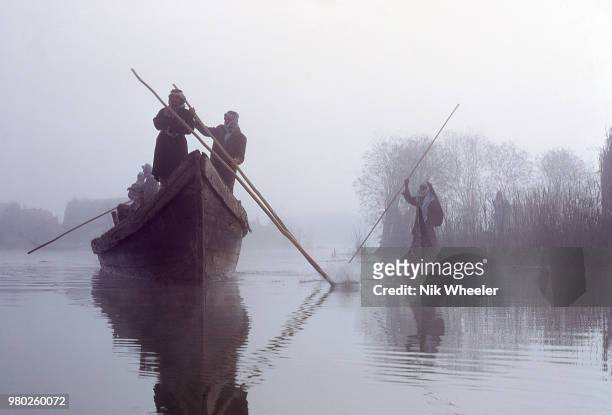

IMAGES
VIDEO
COMMENTS
The Mesopotamian Sailboat. Mesopotamia, tucked beneath the Tigris and the Euphrates rivers and home to the community of Sumer, was one of the earliest civilizations on the planet, but there were other civilizations nearby. ... was a thriving civilization with art, music and writing. Because Mesopotamia was scarce in terms of natural resources ...
Sumerian art was beautifully decorated with ornamentations and served religious and sacred purposes. Many of the Sumer art objects were discovered from gravesites and were buried with their respective owners. Temples were important structures and were given great care in construction for the purposes of venerating respective deities.
Sailboats facilitated transportation of people and goods upstream and downstream, even in difficult waterways and bad weather. (Source: Our Team) The invention of the sailboat also had military implications; the Sumerians modified the boats for warfare by adding platforms, raising the sides, and adding battering rams. (Source: Our Team)
Mesopotamian reed boats constitute the earliest known evidence for deliberately constructed sailing ships, dated to the early Neolithic Ubaid culture of Mesopotamia, about 5500 B.C.E.The small, masted Mesopotamian boats are believed to have facilitated minor but significant long-distance trade between the emerging villages of the Fertile Crescent and the Arabian Neolithic communities of the ...
Ancient Mesopotamian art and architectural works are among the oldest in the world, dating back over 7,000 years. The works first appear in northern Mesopotamia prior to the Ubaid Period (c. 5000-4100 BCE) and then developed in the south during the Uruk Period (4100-2900 BCE) in Sumer which established the first historical civilization.. According to some scholars, the works of the Indus ...
Learn for free about math, art, computer programming, economics, physics, chemistry, biology, medicine, finance, history, and more. Khan Academy is a nonprofit with the mission of providing a free, world-class education for anyone, anywhere.
Old Sumerian Art. IT is a pure joy for a weary archaeologist to plunge into a study of Oriental art—the oldest known Mesopotamian art—thanks to the rich collection of objects, figures, statues, reliefs, and engravings discovered in the predynastic cemetery at Ur. A new stage of civilization, perfectly unknown a year ago, has now been reached.
Early civilizations began to form around the time of the Neolithic Revolution—12000 BCE. Some of the major Mesopotamian civilizations include the Sumerian, Assyrian, Akkadian, and Babylonian civilizations. Evidence shows extensive use of technology, literature, legal codes, philosophy, religion, and architecture in these societies.
The Sumerians began to build their walled cities and make significant advances beginning around 3500 B.C.E. Their domination of this region lasted until around 2000 B.C.E, when the Babylonians took control. Sumerian culture and technology did not disappear but were adopted by its conquerors. Located in what the ancient Greeks called Mesopotamia ...
The Sumerians began to build their walled cities and make significant advances beginning around 3500 B.C.E. Their domination of this region lasted until around 2000 B.C.E, when the Babylonians took control. Sumerian culture and technology did not disappear but were adopted by its conquerors. Located in what the ancient Greeks called Mesopotamia ...
The beginnings of monumental architecture in Mesopotamia are usually considered to have been contemporary with the founding of the Sumerian cities and the invention of writing, about 3100 bce. Conscious attempts at architectural design during this so-called Protoliterate period ( c. 3400- c. 2900 bce) are recognizable in the construction of ...
DeAgostini/Getty Images. A Mesopotamian woman weaving. While other cultures in the Middle East gathered wool and used it to weave fabric for clothing, the Sumerians were the first to do it on an ...
Ancient Egypt and Mesopotamia used sail boats for transportation, exploration, and trade. The Egyptians were skilled sailors who utilized wind power to navigate the Nile River and the Red Sea. They could travel longer distances and carry larger quantities of goods. In Mesopotamia, sail boats were also prevalent.
Mesopotamia is important because it witnessed crucial advancements in the development of human civilisation between 6000-1550 BC. The word 'mesopotamia' comes from the ancient words 'meso', which means 'middle', and 'potamos', which means 'river or stream'. Mesopotamia is the land between the Tigris and Euphrates rivers (now Iraq, north-east ...
From the boat's archaeological context, the team determined that it is likely around 4,000 years old, which would place it toward the end of the Ur III Period (c. 2112-2004 B.C.E.) or the beginning of the Isin-Larsa Period (c. 2004-1763 B.C.E.). Due to fear of additional damage, the team covered the boat in a clay and plaster shell before ...
It is still used to draw water in many parts of the world that do not have ready access to electric water pumps. In many ways, a shadoof resembles a seesaw. ... Rick Mesopotamian Ancient Basket Weaving Technology and the Sumerian Reed Industry Page 82 Copper was delivered by boat as Mesopotamia had no copper of its own. Initially, before wooden ...
Sumerian. Also known as. Sumerian. Scope note. Sumerian is not used as a period culture term but as a language (see inscription field), instead see narrower terms. The period from circa 3000 BC-2350 BC in southern Mesopotamia is sub-divided into three main phases known as Early Dynastic I, II & III. Part of this region at this period ...
The Sumerians invented sailboats, utilizing wind power for navigation. These innovative vessels transformed maritime travel, facilitating trade and exploration. By harnessing the wind's energy, the Sumerians expanded their reach and established connections with distant cultures. ... For some reason, there are certain people who draw alien ...
Sumerian Art and Architecture. Architecture on a grand scale is generally credited to have begun under the Sumerians, with religious structures dating back to 3400 B.C., although it appears that ...
Sumer (/ ˈ s uː m ər /) is the earliest known civilization, located in the historical region of southern Mesopotamia (now south-central Iraq), emerging during the Chalcolithic and early Bronze Ages between the sixth and fifth millennium BC. Like nearby Elam, it is one of the cradles of civilization, along with Egypt, the Indus Valley, the Erligang culture of the Yellow River valley, Caral ...
The Sumerians were the people of southern Mesopotamia whose civilization flourished between c. 4100-1750 BCE. Their name comes from the region which is frequently - and incorrectly - referred to as a "country". Sumer was never a cohesive political entity, however, but a region of city-states each with its own king.. Sumer was the southern counterpart to the northern region of Akkad ...
Ancient Near East. during the. Uruk period. One of these was the use of art to illustrate the role of the ruler and his place in society. The Warka Vase, c. 3000 B.C.E., was discovered at Uruk (Warka is the modern name, Uruk the ancient name), and is probably the most famous example of this innovation. In its decoration we find an example of the.
Browse Getty Images' premium collection of high-quality, authentic Mesopotamia Boat stock photos, royalty-free images, and pictures. ... Iraq, drawing by Regis from Journey to Mesopotamia, 1840-1842, by Eugene Flandin , from Il Giro del mondo ,... View of al-Hilla, on Euphrates river, by Regis.